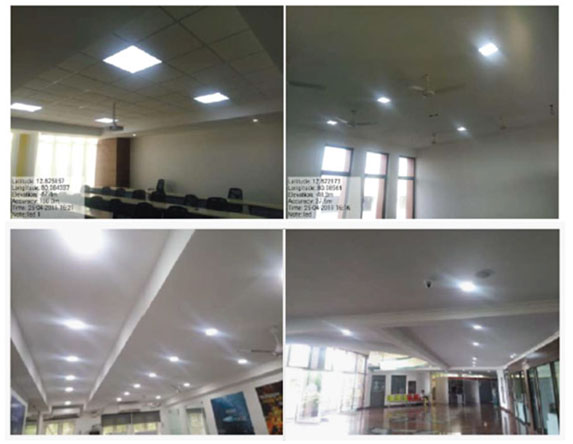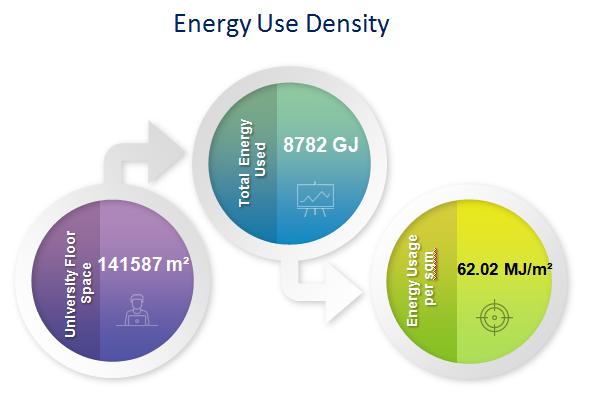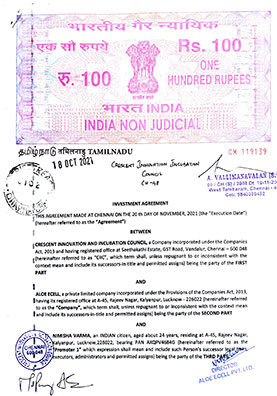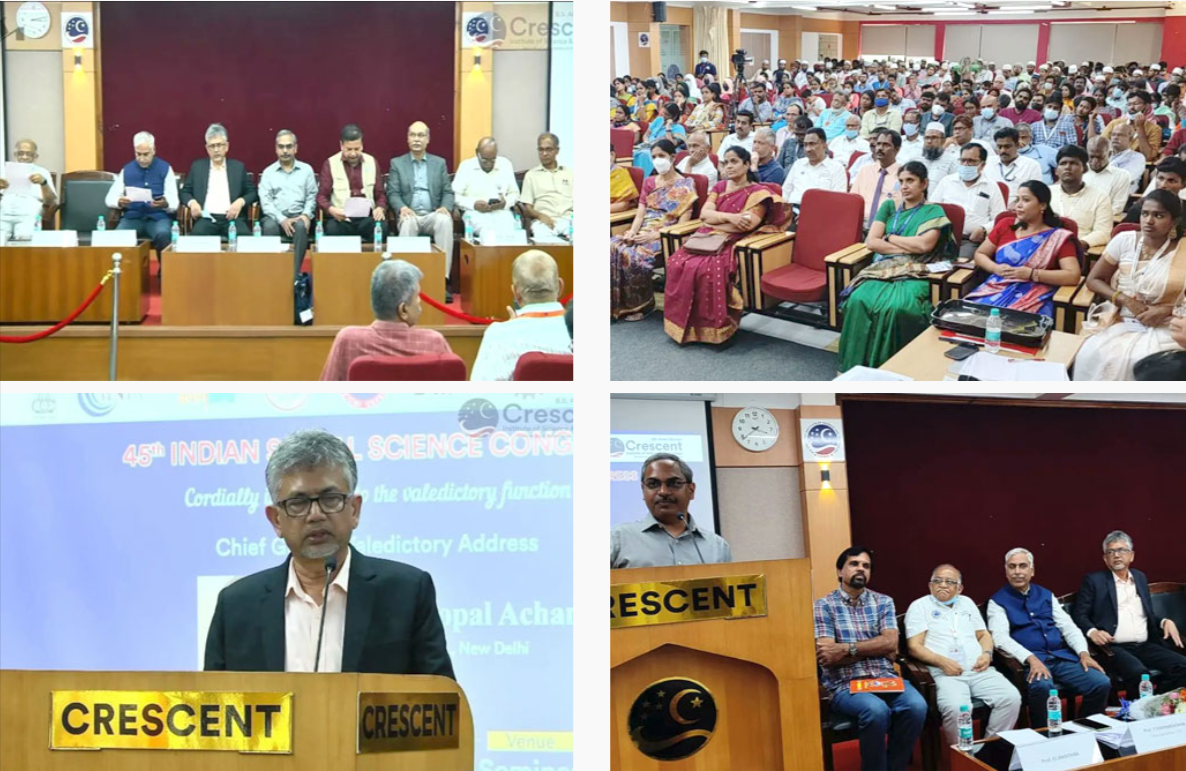Crescent Sustainability Initiatives
Affordable and Clean Energy (SDG 7)

Responsible Executive: Director (IQAC)
Responsible Office: Internal Quality Assurance Cell, Estate Office, and SDG Cell
Contacts: Registrar, Director (IQAC)
7.1 STATEMENT OF POLICY
- Ensure universal access to affordable, reliable and modern energy services
- Increase substantially the share of renewable energy in the global energy mix
- Double the global rate of improvement in energy efficiency
- Enhance international cooperation to facilitate access to clean energy research and technology, including renewable energy, energy efficiency and advanced and cleaner fossil-fuel technology, and promote investment in energy infrastructure and clean energy technology
- Expand infrastructure and upgrade technology for supplying modern and sustainable energy services for all in developing countries, in particular least developed countries, small island developing States, and land-locked developing countries, in accordance with their respective programmes of support
| Upgrade buildings to higher energy efficiency | https://crescent.bytdigital.com/iqac-csi-sdg7-2021-23/#ubhee |
| Carbon reduction and emission reduction process | https://crescent.bytdigital.com/iqac-csi-sdg7-2021-23/#crer |
| Plan to Reduce Energy Consumption | https://crescent.bytdigital.com/iqac-csi-sdg7-2021-23/#prec |
| Energy waste identification | https://crescent.bytdigital.com/iqac-csi-sdg7-2021-23/#ewi |
| Local community outreach | https://crescent.bytdigital.com/iqac-csi-sdg7-2021-23/#lco |
| Renewable Energy Pledge | https://crescent.bytdigital.com/iqac-csi-sdg7-2021-23/#rep |
| Energy efficiency services for industry | https://crescent.bytdigital.com/iqac-csi-sdg7-2021-23/#eesi |
| Policy – Clean Energy Technology | https://crescent.bytdigital.com/iqac-csi-sdg7-2021-23/#pct |
| Low – carbon innovation | https://crescent.bytdigital.com/iqac-csi-sdg7-2021-23/#lcin |
Academic Year 2020-21
Renewable Energy
The demand that is contracted from TANGEDCO is 1200 KVA and the backup power capacity is 2350 KVA(100%).
Solar Power
Three roof top solar power plants are present inside the campus and the capacity of the first solar power plant is of 150 kWp commissioned in June 2014 at a cost of 1.32 Cr. The second solar power plant is of 100 kWp commissioned in October 2014 at a cost of 62 Lacs. New roof top Solar Power Plant III is of 300 kWp capacity and it was commissioned in October 2018 at a cost of 1.20 Cr. So the total power generated through the solar plant is 27,04,654 units till 31st July 2020 and our average monthly energy savings is 43%. Installation of additional 100 kWp Solar PV project on the RCC Roofs of School of Architecture Building and Innovation & Incubation Centre at a cost of Rs. 40 lakhs (work in progress). The campus also has an Online monitoring solar power system.
Solar Water Heaters
Three solar water heaters having a capacity of 36,500 litres which is equivalent to 365 numbers are installed. By this the saving of power is approximately Rs. 24 lacs per annum. Sub meters are provided in canteens, hostels and quarters.
Solar Street Lights
Solar street lights have been installed in the campus by a 3rd year EEE students along with our estate electrical department team. It is installed towards staff quarters to Men’s hostel road and Architecture block area.
Bio gas Plant
A bio gas plant of 50m3 capacity was commissioned in the Ladies Hostel in the month of June 2017 to recycle the food waste generated from the Hostel mess and Canteen in the campus. The bio gas generated is used in the Ladies Hostel mess kitchen.
The Institute has a bio gas plant in order to handle the food waste generated from hostel kitchens and canteens. It will generate 15-20m3/day from the plant and the same shall be used for the cooking purposes at hostel kitchen and canteens. The total project amount is 35 lakh and the Institute have contributed Rs.10 lakh.
Energy efficient Appliances in Campus
LED fixtures are being extensively used for all new interior renovation works in the campus. So far, 50.87 kW capacity of LED lights are fixed which provide around 70% of energy saving compared to conventional lighting.
With an emphasis to energy conservation, all split AC units purchased since the year 2012 are of BEE 5- star energy rating. The AC units are free from ozone depleting CFC.
Motion sensor lights are provided in computer science lab, staff cabins and toilets for energy savings.
The Institute is a proud owner of “Tissue Cultured bamboo plant” of variety “Beema.” This is one of the super bamboo, developed by the Biotechnology lab, grown in greenhouse for six months and now it is ready for planting in the soil. The full growth of the bema bamboo is achieved only by providing the best care by us; both at the time of planting and growing it for at least 4 to 5 years. Every plant when it is fully grown to its best growth generates over 300kg of oxygen every year, it is just sufficient for one person for a whole year.
The Institute has an Air Quality Sensor Station which helps to know the air quality.
Recognitions
ASSOCHAM award ” University of the year for Eco-Friendly Sustainable Campus” for its eco-friendly self-sustaining efforts in conserving the environment. The award was presented by Dr. Mahendra Nath Pandey, Hon’ble Minister of Skill Development and Entrepreneurship, Govt. of India in 2020.
Energy – efficient renovation and building

What is Sustainability?
United Nations World Commission on Environment and Development defines Sustainability as:
“Development that meets the needs of present generations without compromising the ability of future generations to meet their own needs.”
Energy Conservation Measures
Comprehensive simulation studies were conducted to model the buildings energy consuming systems and reduce the whole building energy consumption of about 10.5%.
- Walls made of AAC/Aerocon blocks & Porotherm blocks & energy efficient roof configurations to reduce heat ingress
- Efficient chiller machines
- Variable frequency drives in pumps, Cooling towers and AHUs which regulate the energy consumption depending on occupancy.
- Heat Recovery wheels
- Selection of high performance glass which lets in very less heat
- Efficient lighting design with the use of CFLs and T5s
- Low power consumption fan
- Lighting design has been done to maximize visual comfort with minimum lighting power density
- External fins Shadings
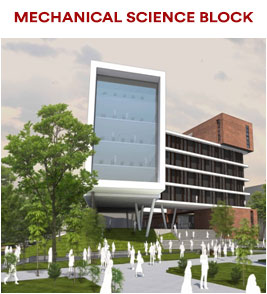
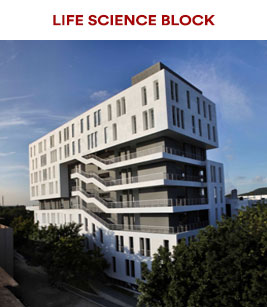
- Walls made of AAC/Aerocon blocks & energy efficient roof configurations to reduce heat ingress
- Efficient Air conditioning system
- Selection of high performance glass to reduce heat ingress
- Efficient lighting design with the use of CFLs and T5s
- Reflective Roof with Under deck insulation
- Heat Recovery wheels
- Low power consumption fans to reduce energy
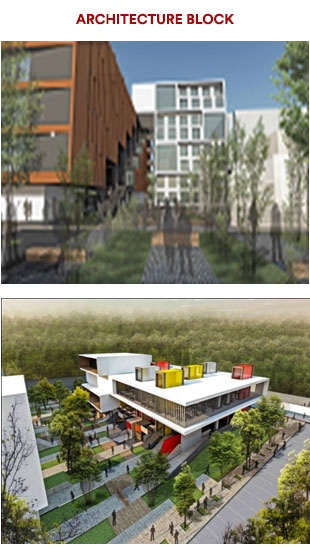
- The building is well designed to harvest natural lighting such that over 75% of each apartment will be well lit and will not require artificial lighting during the day time to provide a nicer environment and save on energy
- High Performance Building envelope i.e., with Aerocon blocks. This reduces the overall heat ingress and hence reduces the overall building electricity power consumption.
- Use of efficient lighting systems to reduce the overall energy consumption.
- Provision of a detailed metering system to ensure that adequate measurement and monitoring of all systems in the building has been done to continuously monitor the building
- Provision of solar hot water system.
- Provision of minimum BEE 4/5 star CFC free split units
- External shading devices
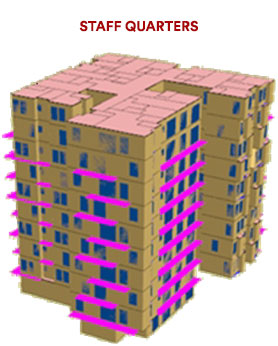

- Window to wall ratio: Optimum design of Window sizes to bring maximum natural light but minimize heat
- The building is well designed to harvest natural lighting such that over 75% of each apartment will be well lit and will not require artificial lighting during the day time to provide a nicer environment and save on energy
- External shading devices to reduce solar radiation
- High Performance Building envelope i.e., with Aerocon blocks. This reduces the overall heat ingress and hence reduces the overall building electricity power consumption.
- Use of efficient lighting systems to reduce the overall energy consumption.
- Provision of solar hot water system.
- Provision of minimum BEE 4/5 star CFC free split units
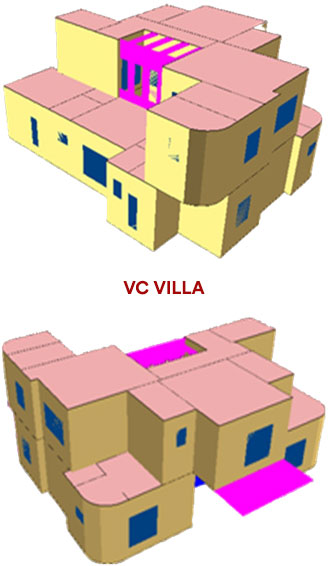
National Building Code of India 2016 (NBC 2016)
The National Building Code of India (NBC) provides guidelines for regulating the building construction activities across the country. It serves as a Model Code for adoption by all agencies involved in building construction works. The Code mainly contains administrative regulations, development control rules and general building requirements; fire safety requirements; stipulations regarding materials, structural design and construction (including safety); building and plumbing services; approach to sustainability; and asset and facility management
https://www.bis.gov.in/index.php/standards/technical-department/national-building-code/
Green Building Certificate and LEED
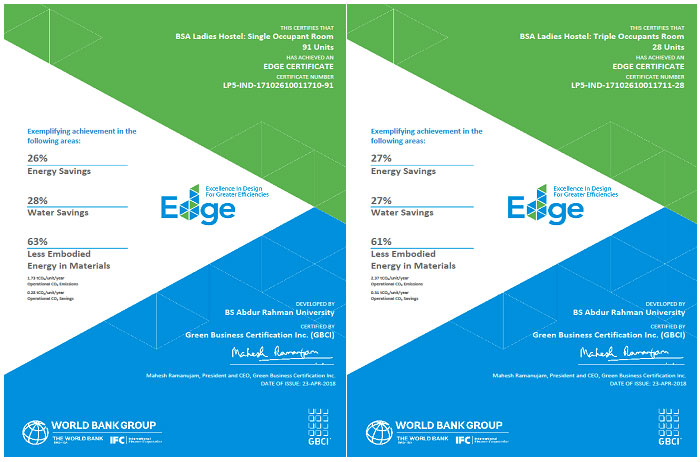

New Crescent School of Architecture block, is designed as a Net Zero Energy building and registered under USGBC-LEED Gold certification
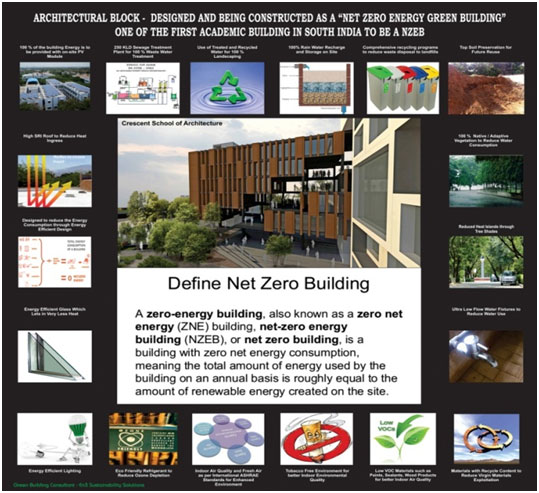
B.S.Abdur Rahman Crescent Institute of Science and Technology undertakes initiatives to obtain energy from various natural resources. The Institute is pioneer in establishing renewable energy sources to meet the energy requirement of the campus.
Three Roof top solar power plants of total capacity of 650 KWp (against the sanctioned demand of 1200 KW)are installed in our campus.
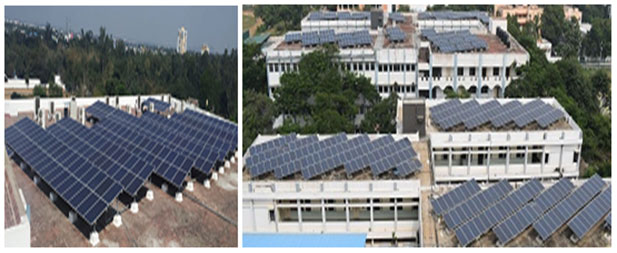
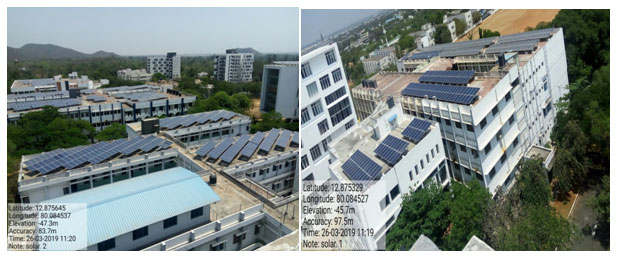
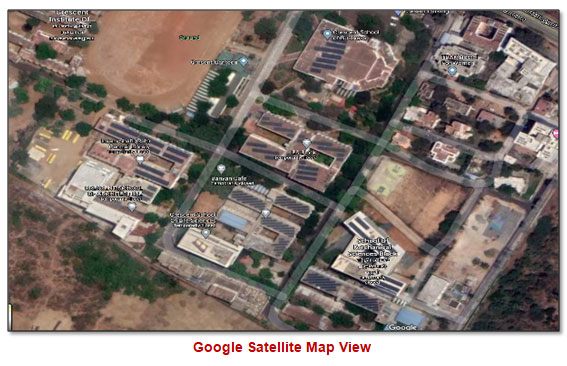
If a Solar Power Plant is connected with DG SET and the power consumption of connected Load is lower than the power generated by solar power plant, then the excess of power generated by solar power plant will reverse back to DG SET and this will lead to permanent damage of DG SET. Zero Export device has been installed to limit the surplus amount of solar power that their systems export to the DG SET.
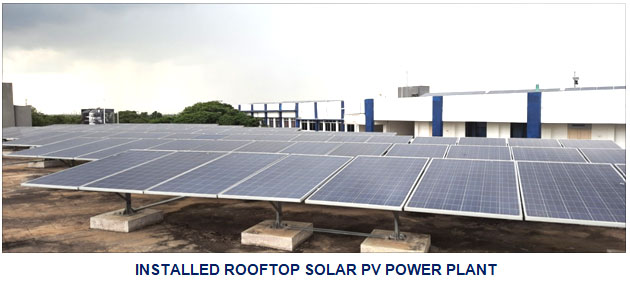
Installed 550 kWp Rooftop solar plant shares all the power generated with DG set to reduce its dependence on diesel as fuel.
Most recently, a 100 kWp rooftop plant is installedin New Architecture Block and CIIC Block. This installation shall run in parallel to the existing 550 kWp solar plants.
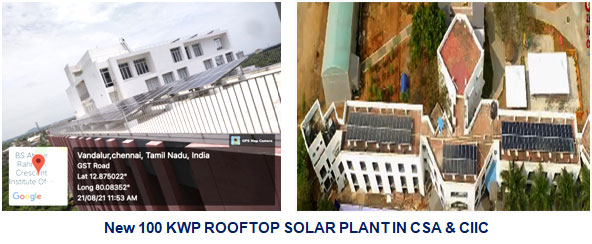
| 150kWp Solar PV Power Plant – Generation from 2014 – 2022 | |||
|---|---|---|---|
| S.No | Year | Units Generated (kWh) | Amount saved (in Rs) |
| 1 | 2014 | 1,03,248 | 8,77,615 |
| 2 | 2015 | 2,14,937 | 18,26,969 |
| 3 | 2016 | 2,05,374 | 18,42,140 |
| 4 | 2017 | 1,93,912 | 16,57,963 |
| 5 | 2018 | 1,98,162 | 17,12,369 |
| 6 | 2019 | 1,96,269 | 16,83,398 |
| 7 | 2020 | 1,81,064 | 19,52,642 |
| 8 | 2021 | 1,43,328 | 14,29,591 |
| 9 | 2022 | 98,244 | 9,16,039 |
| Total | 15,34,538 | 1,38,98,726 | |
| 100kWp Solar PV Power Plant – Generation from 2014 – 2022 | |||
|---|---|---|---|
| S.No | Year | Units Generated (kWh) | Amount saved (in Rs) |
| 1 | 2014 | 17,458 | 1,48,398 |
| 2 | 2015 | 1,46,940 | 12,48,990 |
| 3 | 2016 | 1,50,730 | 13,56,665 |
| 4 | 2017 | 1,41,458 | 12,08,720 |
| 5 | 2018 | 1,50,464 | 13,00,737 |
| 6 | 2019 | 1,42,965 | 12,26,905 |
| 7 | 2020 | 1,29,606 | 13,95,243 |
| 8 | 2021 | 1,15,222 | 11,67,496 |
| 9 | 2022 | 1,12,684 | 10,50,386 |
| Total | 11,07,527 | 1,01,03,540 | |
| 300kWp Solar PV Power Plant – Generation from 2018 – 2022 | |||
|---|---|---|---|
| S.No | Year | Units Generated (kWh) | Amount saved (in Rs) |
| 1 | 2018 | 41,037 | 3,74,495 |
| 2 | 2019 | 4,19,309 | 35,95,084 |
| 3 | 2020 | 2,98,201 | 31,55,265 |
| 4 | 2021 | 2,69,365 | 26,69,998 |
| 5 | 2022 | 3,62,203 | 33,52,685 |
| Total | 13,90,115 | 1,31,47,527 | |
| 100kWp Solar PV Power Plant – Generation -2021- 2022 | |||
|---|---|---|---|
| S.No | Year | Units Generated (kWh) | Amount saved (in Rs) |
| 1 | 2021 | 1,03,089 | 10,42,948 |
| 2 | 2022 | 1,31,401 | 12,24,266 |
| Total | 2,34,490 | 22,67,214 | |
| Total Solar Power Generation – 650kWp upto 31st December 2022 | ||
|---|---|---|
| Plant | Units (kWh) | Amount (in Rs) |
| 150Kwp | 15,34,538 | 1,38,98,726 |
| 100kWp | 11,07,527 | 1,01,03,540 |
| 300kWp | 13,90,115 | 1,31,47,527 |
| New 100kWp | 2,34,490 | 22,67,214 |
| Total | 42,66,670 | 3,94,17,007 |
The number of units generated through solar power plants constitute 16% of total electricity consumption since June 2014.
Installed total capacity of 39,500 liters. This is equivalent to 365 Nos electric geysers of 2kW capacities. The power saving is estimated to be around 24 Lacs per annum.

| Men’s Hostel | ||
| Block | No. of tanks | Capacity in liters |
| A Block | 20 | 5000 |
| B Block | 6 | 3000 |
| C Block | 6 | 3000 |
| D Block | 8 | 4000 |
| Main block | 20 | 5000 |
| PG block | 12 | 3000 |
| Ladies Hostel | ||
| Main block | 10 | 5000 |
| Annexure Block | ||
| New Block Phase 1 | 17 | 5750 |
| Staff Quarters | ||
| New Staff Quarters | 23 | 5750 |
| Total Capacity | 122 | 39,500Litres |
Installed towards staff quarters to Men’s hostel road and Architecture block area. This project was done by our III yr. EEE students along with our Estate electrical dept. team.
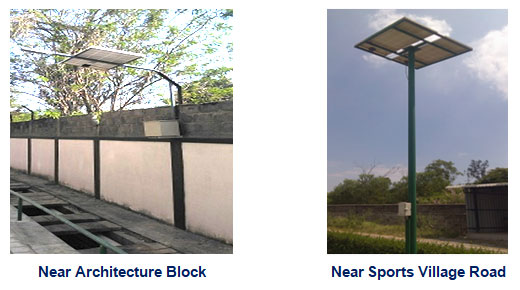
Academic Year 2020-21
LED light fixtures are being extensively used for all new interior renovation works in the campus. So far, 86.31 kW capacities of LED lights are fixed which provide around 80% energy saving compared to conventional lighting.
| SL NO | BUILDING | QTY | TOTAL WATTS |
|---|---|---|---|
| 1 | AUDITORIUM | 176 | 2459 |
| 2 | SCIENCE BLOCK | 280 | 3429 |
| 3 | AERO BLOCK | 563 | 6764 |
| 4 | MAIN BLOCK | 182 | 4252 |
| 5 | MBA BLOCK | 83 | 1797 |
| 6 | FIRST YEAR BLOCK | 87 | 1705 |
| 7 | LIFE SCIENCE BLOCK | 92 | 2058 |
| 8 | NEW STAFF QUARTERS | 361 | 4695 |
| 9 | LADIES HOSTEL | 614 | 7359 |
| 10 | CAMPUS STREET LIGHT | 256 | 7130 |
| 11 | MEDICAL | 27 | 429 |
| 12 | PHARMACY | 127 | 2255 |
| 13 | GM OFFICE | 47 | 910 |
| 14 | MAIN CANTEEN | 39 | 882 |
| 15 | VC OFFICE | 78 | 510 |
| 16 | VC VILLA | 37 | 393 |
| 17 | GUEST HOUSE | 37 | 680 |
| 18 | DRIVERS CABIN | 8 | 120 |
| 19 | OLD STAFF QUARTERS | 45 | 845 |
| 20 | SPORTS LIGHTING | 29 | 5800 |
| 21 | HR OFFICE | 25 | 460 |
| 22 | PARANTS WAITING HALL | 12 | 166 |
| 24 | NEW ARCHITECTURE BLOCK | 598 | 10488 |
| 25 | CIVIL YARD CLASS ROOMS | 40 | 650 |
| 26 | CSB ROOM MENS HOSTEL | 47 | 780 |
| 27 | ROBOTICS LAB | 22 | 280 |
| 28 | RESEARCH SCHOLAR ROOM CHEMISTRY | 4 | 144 |
| 29 | FOOD WASTE MANAGEMENT PLANT | 23 | 520 |
| 30 | SOLAR STREET LIGHT | 10 | 250 |
| 31 | MENS HOSTEL | 532 | 7999 |
| 32 | MBA PHASE 1 | 49 | 595 |
| 33 | MBA PHASE 2 | 170 | 3108 |
| 34 | COMPUTER SCIENCE LAB | 51 | 690 |
| 35 | PURCHASE OFFICE (EO) | 2 | 30 |
| 36 | CIIC BLOCK | 88 | 1624 |
| 37 | CIIC 2ND FLOOR STUDIO | 13 | 225 |
| 38 | DRAWING HALLS & LABS(MECH) | 60 | 709 |
| 39 | BAMBOO CAFÉ, BANYAN CAFÉ etc | 104 | 1816 |
| 40 | OUTDOOR LIGHTING | 63 | 1306 |
| TOTAL | 5081 | 86,312 | |
Energy Efficient LED Lamps
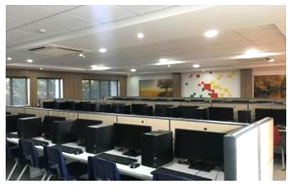
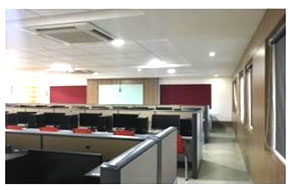
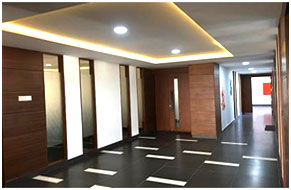
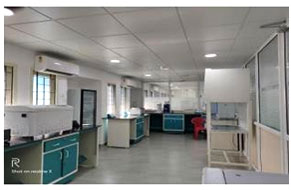
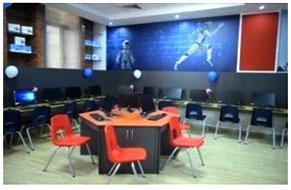

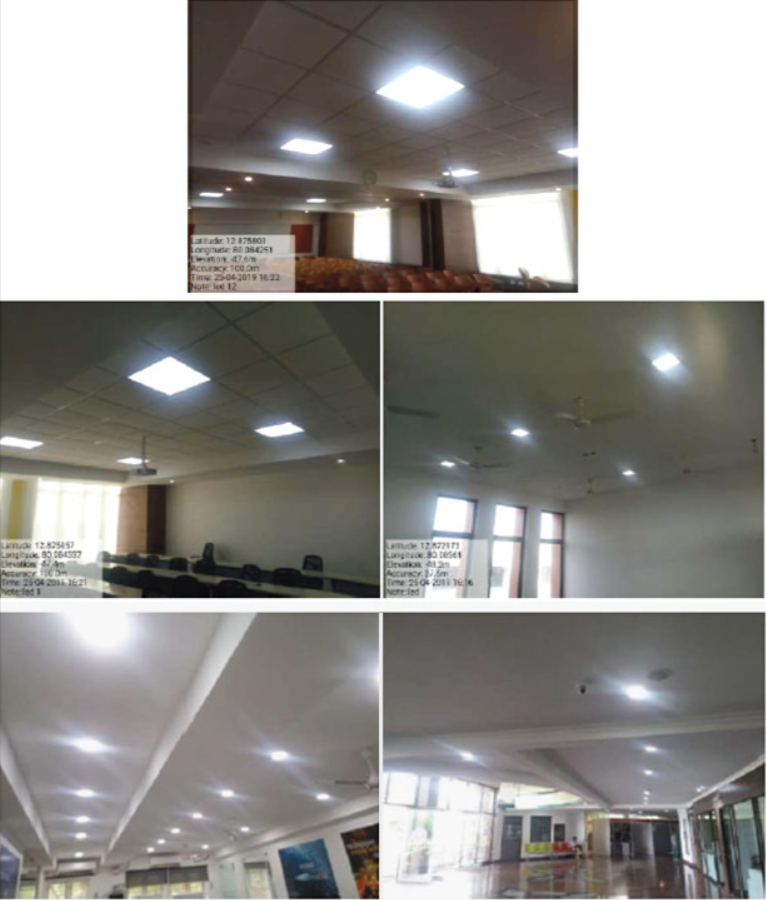
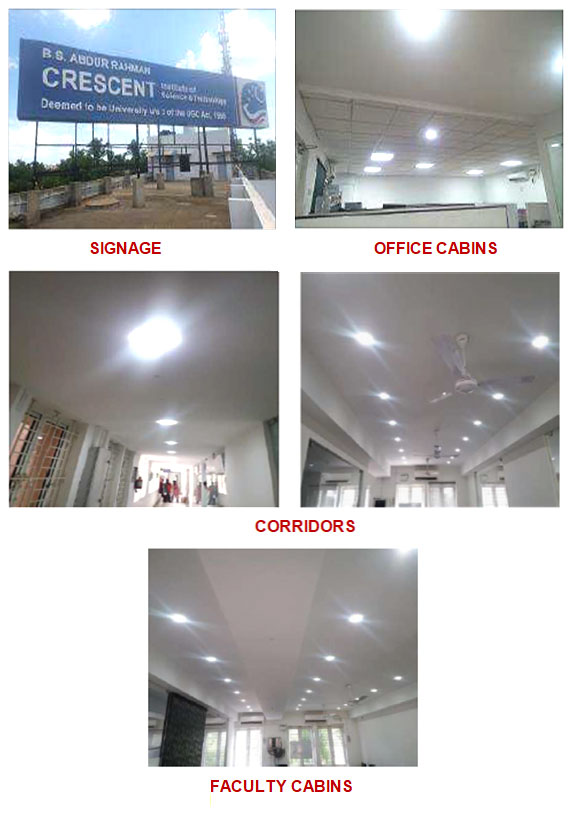
AC Units
Bureau of Energy Efficiency (BEE) 5-Star Rated Air Conditioners
With an emphasis to energy conservation, all split AC units purchased since the year 2012 are of BEE 5-star energy rating. The AC units are free from ozone-depleting CFC
| MODEL | QTY | TON |
|---|---|---|
| 1.0 TON Split Inverter | 17 | 17 |
| 1.5 Ton Split 5* | 29 | 44 |
| 2.0 Ton Split 5* | 71 | 142 |
| TOTAL | 117 | 203 |
Old Spilt AC units and window AC units have been replacing gradually with centralized VRF AC units for energy savings. The VRF AC unit saves space, cost and electricity consumption.
Passive Infrared Motion Sensor Lights
Motion sensor lights are provided in computer science lab, staff cabins and toilets for energy savings.
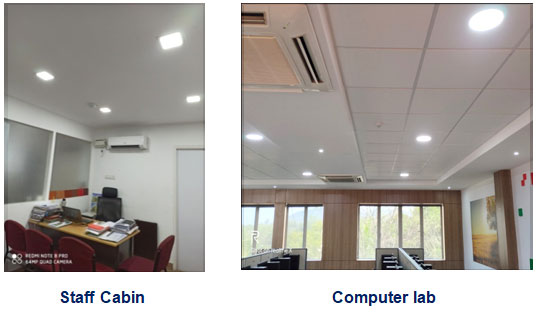
Carbon Footprint of 650 kWp Plant
In BS Abdur Rahman Crescent Institute of Science and Technology, 550 kWp polycrystalline and 100 kWp monocrystalline roof top solar photovoltaic plants are commissioned. The site is receiving average solar radiation of 4.82 kWh/m²/day. The 550 kWp polycrystalline and 100 kWp monocrystalline plants are operational since October 2014 and April 2021 respectively.
Solar plant is aimed purely for captive consumption at our institute. Our installed Rooftop Solar power plant has a fixed tilt system. The real time parameters are collected from data acquisition software which has been provided by Fourth Partner Energy (4PEL), India.
Institution 650 kWp solar panels generate clean and renewable energy, which significantly reduces carbon footprint.
1kW solar plant offsets about 0.73 tons of CO2 emissions.
So a 650 kWp solar plant will offset = 474 tons of CO2 emissions
A tree can absorb as much as 22 kg of CO2 per year.
So going solar will offset planting around 4,74,000/22= 21,545 trees.

Table VII – 8: The measures taken for carbon reduction on the campus
| Renewable energy | https://crescent.bytdigital.com/iqac-csi-sdg7-2021-23/#ubhee |
| Oxy Zone Campus – Beema Bamboo Plantation | Beema Bamboo Planataion |
| Eco Friendly Vehicles @ Crescent | Eco-Friendly Conveyance |
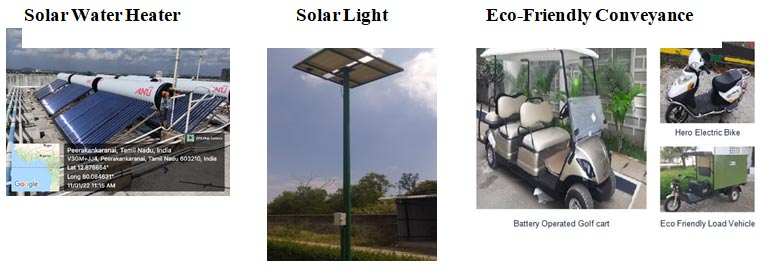
Academic Year 2020-21
B.S.Abdur Rahman Crescent Institute of Science and Technology is searching for ways to lessen the cost and effect on the environment related with their green initiatives. 38% of Carbon foot print is offset by the environment – friendly measures in campus and 10% Carbon Offsetting.
Carbon Footprint
| Carbon foot print / Capita | ||||||
|---|---|---|---|---|---|---|
| Activity Data | Type | unit | GHG | Emission factor | Quantity | CO2 emission /year |
| Transportation | petrol | litres | Kg CO2e | 2.196 | 1300 | 2855 |
| diesel | litres | 2.65 | 381461 | 1010872 | ||
| Electricity | kWh | Kg CO2e | 1.2 | 4376492 | 5251791 | |
| Paper consumption | kg | Kg CO2e | 0.683 | 21900 | 14958 | |
| Water consumption | water supply | cum | Kg CO2e | 0.8 | 160611 | 128489 |
| Solid waste | kg | Kg CO2e | 3.7 | 259560 | 960372 | |
| Total CO2 Emission Per Year | Kg | Kg CO2e | 7369336 | |||
| Over all carbon foot print / year | Ton | 7369 | ||||
| Total population (avg) | 7000 | |||||
| Carbon Foot Print per capita in Ton | 1.05 | |||||
| National average per capita | 1.58 Ton/Capita/Year |
| Actual CO2 emission | 1.05 Ton/Capita/Year |
| % of CO2 emission – on national avg. | 66.63% |
| % of CO2 reduced from National avg. | 33.37% |
| Total Carbon Emission : 7369 tons/year | ||||
| Classification of Green Areas | Area | Unit | CO2 (avg.) absorption rate t/year | Total CO2 absorption ton/year |
| Area of Tree – ref Google Map | 2 | Acre | 160 | 336 |
| Lawn & plant area | 14 | Acre | 15 | 211 |
| Beema Bamboo | 2.5 | Acre | 80 | 200 |
| Total green area in acre | 19 | Acre | ||
| Total CO2 Absorption | 747 | |||
| % of CO2 offset within the campus | 10.13% | |||
| % of Green Area | 37.86% |
- 10 % of Carbon foot print is offset by the above environment – friendly measures in campus.
Calculation:
Carbon Offsetting
Total trees green area – 19 Acres
Total Co2 absorption ton/year – 747 tones
Over all carbon foot print/year (Co2 Emission) – 7369 tones
% of Co2 → offsetting within campus
(747 / 7369 X 100) – 10.13%
Bal: 90% to be offset by planting more trees or trading
% of Linear area (19/50 Acres – carbon foot print) – 38%
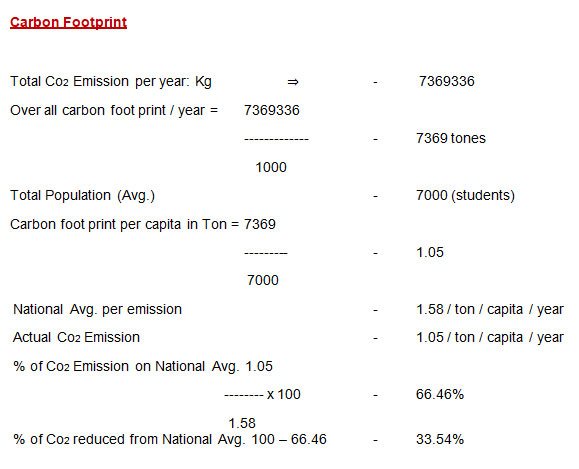
Green Landscaping With Trees And Plants
The campus had 909 trees before the Vardha cyclone in December 2016. A total of 341 trees were uprooted in the cyclone. 451 trees are newly planted in the last 3 years and are being well maintained. Beema Bamboo Plants 2075 numbers has been planted in whole campus to reduce Co2.Now the total number of trees in campus is 3094 Nos. List of trees are available now in our campus and tabulated below.
| TREE NAME | TOTAL Nos |
| NEEM TREE | 272 |
| PORTIA | 51 |
| TAMARIND | 22 |
| MANGO TREE | 33 |
| BRACKEN TREE | 253 |
| COCONUT TREE | 48 |
| SPIKELET | 145 |
| ASH | 40 |
| ARECA | 49 |
| CASUARINA | 36 |
| SPASMA | 6 |
| ALMONDS | 18 |
| KING TREE | 3 |
| BANYAN TREE | 4 |
| PALMYRA | 4 |
| TEAK TREE | 35 |
| BEEMA BAMBOO PLANTS | 2075 |
| TOTAL | 3094 |

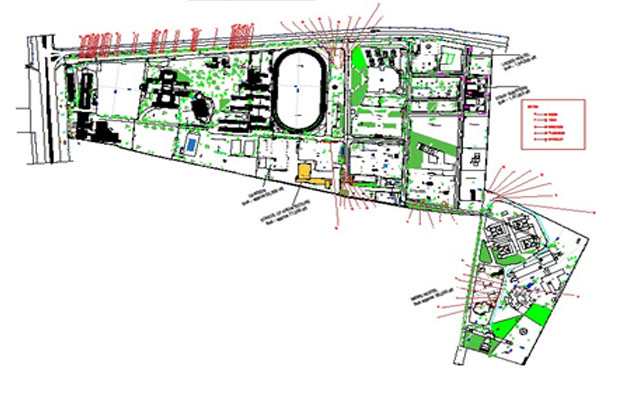
Oxyzone Campus – Beema Bamboo Plantation
Planted bamboo saplings for 5000 run area throughout our compound to absorb dust, CO2 and to release more oxygen and to create pollution free environment. In future, Central bus stand will produce lot of pollution inside our campus, by planting bamboo, our campus become dust free zone with good oxygen supply. Our Institute is provided first OXYZONE inside our campus. Beema Bamboo Plants 2000 Nos Planted in whole campus for CO2 reduction.

Oxy Park
Oxy Park created in the campus opposite to Convention Centre
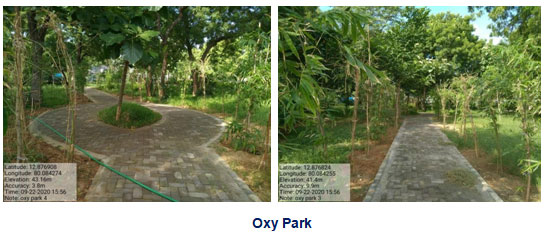
Green Building In Construction
Sustainable and eco-friendly campus development has been adopted with following materials
- Grass Crete: Method of laying Grass paver flooring, walkways, sidewalks and driveways to improve storm water absorption and drainage
- Ash Crete: Fly ash (recycled) content with cement is being used for all Reinforced Cement concrete
- Low – VOC paints: Painting with low VOC less than 50gm/liter is using for all painting works – Nippon and Berger
- Engineered wood: MDF (Medium Densified Fibre) wood used for interior partition, doors and furniture’s.
- Structural Insulated Panels (SIP): Foam board wall panels are used for prefab structures such as class room and indoor game
- Insulated Concrete Forms: GFRC Technology being adopted to construct parent waiting guest rooms and essential staff quarters.
- Steel: Steel roof panels (recyclable) used for workshop roofing.
- Composites: Roof panels made of composite materials such as foam sandwiched between two metal sheets used for prefab class room
- Fibreglass: Fibreglass is also used in insulation in the form of Fibreglass batts for interior partition
- AAC Blocks: Autoclaved Aerated Concrete blocks (non- toxic product) are used for the construction of all buildings to reduce low environmental
- Thermatek Roof tile: Heat Resistant Terrace tiles are used for all
- VAV system: Variable air volume HVAC system is adopted to reduce energy consumption
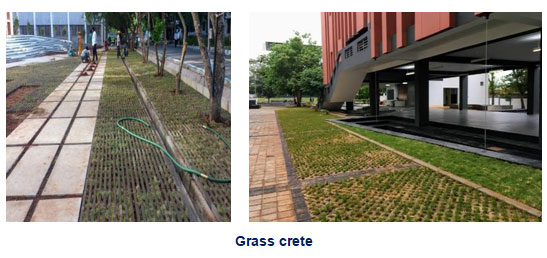
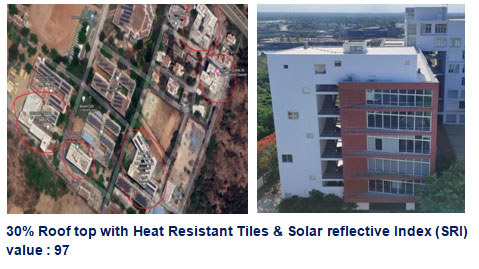
Environment and Campus
- Green open space and Landscape
- Preservation of Eco – system
- Public space for students and staffs – Cafe, Lounge, Square Garden
- Recycling based campus
- Enhancing sustainable consumption of available resources i.e water & Energy.
- Promoting low – carbon practices among campus community.
- Minimizing waste and pollution through effective waste management.
- Innovation in building Design with improved daylight and natural ventilation
Solar Power Plants
A 550 kWp grid tied roof top solar photovoltaic plant commissioned at institution is one of the largest solar power plants with the site receiving a good average solar radiation of 4.97 kWh/m2/day.
As a part of its ‘Green Campus’ initiative, our Institution has set up a 550 kWp grid tied Rooftop Solar PV Power Plant on its academic buildings. The plant is located in the vacant roof space of various buildings.
The outputs from all the plants are connected to the institute grid through local AC distribution boards. This output can be used anywhere in the campus. Available diesel generator set is being used to create the local grid during load shedding.
Installed Rooftop Solar Pv Power Plant
Installed 550 kWp Rooftop solar plant shares all the power generated with DG set to reduce its dependence on diesel as fuel.
Most recently, a 100 kWp rooftop plant is being installed on New Architecture Block and CIIC Block. This installation shall run in parallel to the existing 550 kWp solar plants.
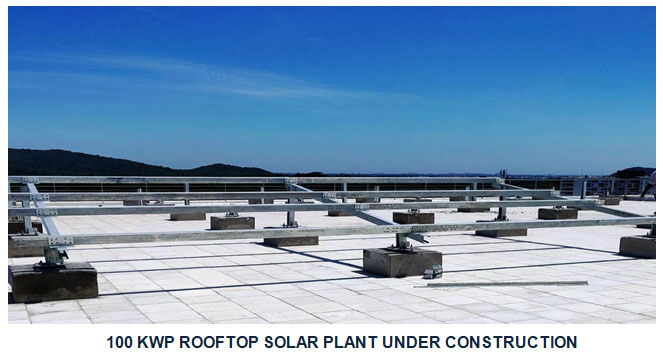
Renewable Energy – Solar Power Plants
B.S.Abdur Rahman Crescent Institute of Science and Technology undertakes initiatives to obtain energy from various natural resources. The Institute is pioneer in establishing renewable energy sources to meet the energy requirement of the campus.
Three Roof top solar power plants of total capacity of 650 KWp (against the sanctioned demand of 1200 KW) are installed in our campus.



As per the CO2 Baseline Database for the Indian Power Sector (CEA), the emissions from grid electricity were about 820 g CO2 equivalent per kWh. Our solar plant can prevent 2000 tonnes of CO2
Eco Friendly Vehicles @ Crescent
Eco-friendly Conveyance
As a step towards complete pollution – free environment in campus, Students and Staffs are commute from Main gate to Hostel and avoid Motor cycle movement inside campus (More than 100 bicycles).
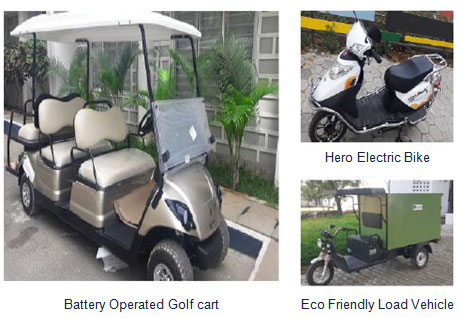
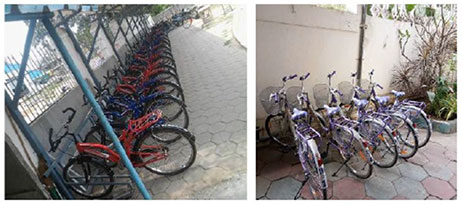
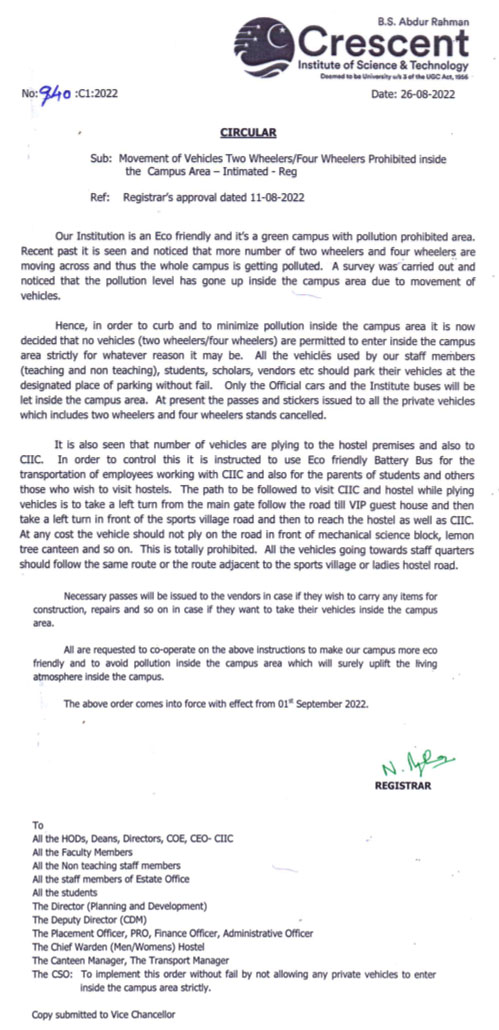
B.S. Abdur Rahman Crescent Institute of Science and Technology campus shall have sustainability as a core principle in building construction, renovation and administration by meticulously following the policy principles mentioned below.
- The building rating system such as EDGE, IGBC Existing Building, LEED NC and IGBC Green Homes shall be achieved for all its existing buildings and new construction projects on campus.
- Sustainable design features and preservation of greenery shall be implemented in all new construction projects to make a completely green and sustainable campus.
- An efficient waste management plan shall be in place to reduce/minimize the amount of waste, reuse/recycle the construction materials and disposal responsibly.
- Rainwater harvesting shall be implemented in all the existing and new buildings across the campus.
- Energy conservation shall be given utmost importance by installing the ISI labelled, BEE star rating, CFC-free electrical appliances and equipment across all the buildings on campus.
- The use of natural lighting, fresh air and solar energy shall be given utmost importance in all the buildings across the campus. The solar panels may be placed in all possible places on building rooftops.
- Audit of building-wise energy consumption in the campus shall be done every year, and take necessary measures to reduce it.
- Adhesives, sealants, paints and coatings used in the buildings shall have low VOC (Volatile Organic Compounds), thereby having minimum organic emissions harmful to humans.
- The eco-friendly housekeeping practices during maintenance/ housekeeping activities shall be adopted by using bio-degradable chemicals, which address the health, hygiene and well-being of maintenance staff and building occupants.
- High reflective roofing materials and green roofs shall be used in all the buildings to reduce the heat island effect.
- Water-efficient landscaping and high-efficiency irrigation technology shall be encouraged in the new construction projects.
- The Research and Development (R & D) activities shall be supported towards energy-efficient renovation and building.
- National/international cooperation shall be enhanced to facilitate access to green building technology to ensure energy-efficient in building construction and renovation.
- The activities to promote energy-efficient renovation and building for local residents, governments, and NGOs shall be conducted through student volunteering, policy development, and technology transfer.
ENERGY SPARING (SMART DOOR LOCK)
EVAPORATIVE AIR COOLING SYSTEM
Figure VII – 9: Installation of Evaporative Air Cooling System to reduce the energy consumption on the campus
LED Fixtures
With an emphasis to energy conservation, all split AC units purchased since the year 2012 are of BEE 5-star energy rating. The AC units are free from ozone-depleting CFC
| MODEL | QTY | TON |
|---|---|---|
| 1.0 TON Split Inverter | 17 | 17 |
| 1.5 Ton Split 5* | 29 | 44 |
| 2.0 Ton Split 5* | 71 | 142 |
| TOTAL | 117 | 203 |
Old Spilt AC units and window AC units have been replacing gradually with centralized VRF AC units for energy savings. The VRF AC unit saves space, cost and electricity consumption.
Motion sensor lights are provided in computer science lab, staff cabins and toilets for energy savings.

Instead of air conditioner, mechanical air circulation is used with natural ventilation to reduce energy consumption in class rooms and staff cabins. Also natural ventilation reduces air pollutants. The ceiling fans and exhaust fans use only a fraction of the energy consumed by an air-conditioner.
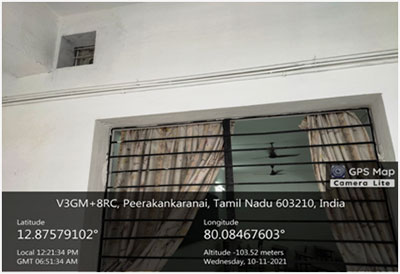
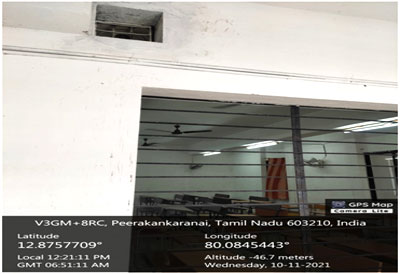
To replace the AC units, ceiling fans, wall mounted fans and exhaust fans have been used with energy conservation measures like ventilating provided by window treatments.
Academic Year 2020-21

Natural Ventilation
Instead of air conditioner, mechanical air circulation is used with natural ventilation to reduce energy consumption in class rooms and staff cabins. Also natural ventilation reduces air pollutants. The ceiling fans and exhaust fans use only a fraction of the energy consumed by an air-conditioner.


To replace the AC units, ceiling fans, wall mounted fans and exhaust fans have been used with energy conservation measures like ventilating provided by window treatments.
BEE 5-Star Rated Air Conditioners
With an emphasis to energy conservation, all split AC units purchased since the year 2012 are of BEE 5-star energy rating. The AC units are free from ozone-depleting CFC
Passive Infrared Motion Sensor Lights
Motion sensor lights are provided in computer lab, staff cabins and toilets for energy savings.

Solar Water Heaters
Installed total capacity of 36,500 liters. This is equivalent to 365 Nos. electric geysers of 2kW capacities. The power saving is estimated to be around 24 Lacs per annum.
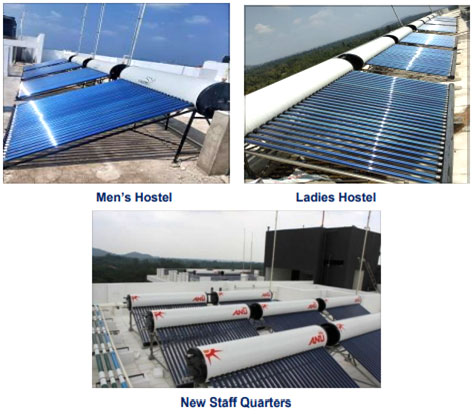
| Men’s Hostel | ||
|---|---|---|
| Block | No. of tanks | Capacity in liters |
| A Block | 20 | 5000 |
| B Block | 6 | 3000 |
| C Block | 6 | 3000 |
| D Block | 8 | 4000 |
| Main block | 20 | 5000 |
| PG block | 12 | 3000 |
| Ladies Hostel | ||
| Main block | 10 | 5000 |
| Annexure Block | ||
| New Block Phase 1 | 11 | 2750 |
| Staff Quarters | ||
| New Staff Quarters | 23 | 5750 |
| Total Capacity | 116 | 36,500Litres |
Solar Street Light
Installed towards staff quarters to Men’s hostel road and Architecture block area. This project was done by our III yr. EEE students along with our Estate electrical dept. team.
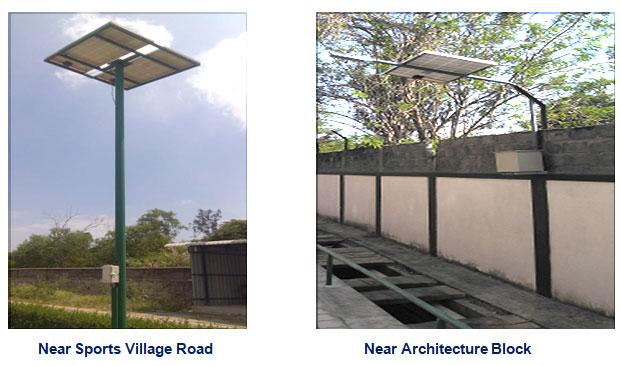
B.S. Abdur Rahman Crescent Institute of Science and Technology intends to follow energy-efficient in the renovation of existing infrastructures and construction of new buildings, thereby reducing the harms of climate change. The energy-efficient renovation and building policy helps reduce the energy generated from conventional energy resources. Further, the policy promotes green buildings across the campus as encouraged by the United Nations and the Government of India to meet SDG 7 – Affordable and Clean Energy.
BSACIST is dedicated to meeting the fundamental criteria outlined in regulations and technical guidelines to uphold Building Standards, ensuring that structures are secure, effective, and environmentally responsible.
The institute is firmly committed to integrating sustainability as a fundamental principle in the construction and ongoing maintenance of its campus infrastructure.
 Figure VII – 13: Environment, Green & Water Audit and Report by Ram-Kalam Centre for Energy Consultation and Training
Figure VII – 13: Environment, Green & Water Audit and Report by Ram-Kalam Centre for Energy Consultation and Training
Walk-thru Energy Audit Report
Of
Crescent Institute of Science & Technology
Vandalur, Chennai
24th Mar 2021
Conducted by
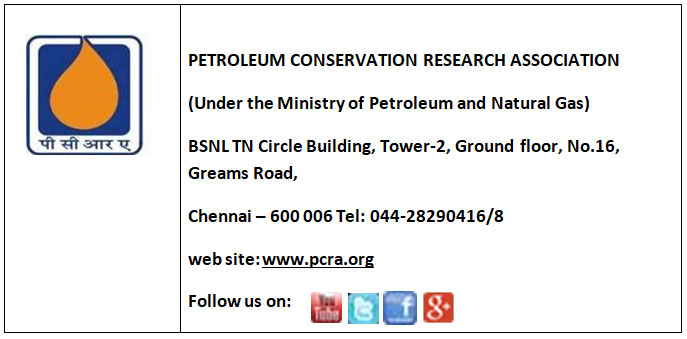
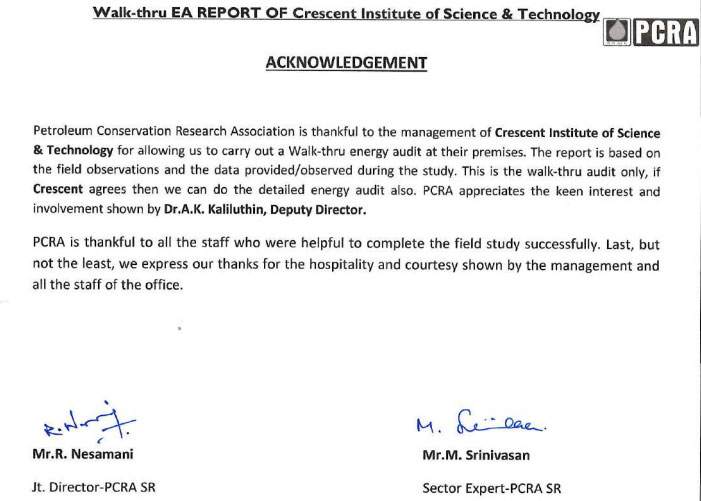
1. Unit Details
| Name of the unit | Crescent Institute of Science & Technology |
| Address of the Unit | Seethakathi Estate, GST Road, Vandalur, Chennai, Tamilnadu-600 048. |
| Coordination In-charge | Mr. Rajkumar |
| Major product manufactured | Science College |
| Name of the PCRA staff involved in study | R. Nesamani & M. Srinivasan |
| Value of Energy Saving identified | 36.2 KLOE/Annum |
| EXECUTIVE SUMMARY – Crescent | |||||
|---|---|---|---|---|---|
| ECM. No | Energy Conservation Measures | Annual Savings | Investment | Payback | |
| kWh | Rs. | Rs. | Months | ||
| 1 | Replace FTL lamps with LED lamps in Office/Class room /Hostel / Quarters | 1,36,000 | 13,60,000 | 17,00,000 | 15 |
| 2 | Replace conventional type fans with BLDC fans in Office/Class room/Hostel/Quarters | 2,41,500 | 24,15,000 | 86,25,000 | 43 |
| 3 | Replace Night lamps with LED lamps in Hostel/Quarters | 43,800 | 4,38,000 | 1,25,000 | 3 |
| Summary of Savings | |||||
| Total Annual kWh Savings by EB | 4,21,300 | 42,13,000 | 1,04,50,000 | 30 | |
| Annual Savings in KLOE by EB consumption | 36.2 | ||||
Savings calculation with payback period will be given after conducting detailed Energy Audit
| Equipment list | ||
|---|---|---|
| Description | Capacity | Quantity in No’s |
| Transformer | 750 kVA | 2 |
| Transformer | 500 kVA | 1 |
| DG | 750 kVA | 1 |
| DG | 500 kVA | 1 |
| Lifts | NA | 23 |
| Chiller | 75TR | 2 |
| VRF AC | 12 TR | 12 |
| Window/Split AC | 1 ~ 2 TR | 350 |
| FTL/CFL lights | 40 W | 3400 |
| Ceiling Fan | 70 W | 3450 |
3. Energy Savings
Total oil Savings Identified is 36.2 KLOE/Annum. It is suggested that the unit shall conduct the detailed energy audit to find out more ECM and also to get details on each ECM.
Other observations: –
1) Window/Split AC has to be replaced with 5 star rated AC
2) Chiller performance study to be conducted & replace if SEC is more
3) Halogen lamps to be replaced with LED lamps
4) Pumps performance to be study during detailed energy audit
5) Solar rooftop performance to be studied
Energy Audit Report 2022 & 2021:
Academic Year 2020-21
Walk-thru Energy Audit Report
Of
Crescent Institute of Science & Technology
Vandalur, Chennai
24th Mar 2021
Conducted by


1. Unit Details
| Name of the unit | Crescent Institute of Science & Technology |
| Address of the Unit | Seethakathi Estate, GST Road, Vandalur, Chennai, Tamilnadu-600 048. |
| Coordination In-charge | Mr. Rajkumar |
| Major product manufactured | Science College |
| Name of the PCRA staff involved in study | R. Nesamani & M. Srinivasan |
| Value of Energy Saving identified | 36.2 KLOE/Annum |
| EXECUTIVE SUMMARY – Crescent | |||||
|---|---|---|---|---|---|
| ECM. No | Energy Conservation Measures | Annual Savings | Investment | Payback | |
| kWh | Rs. | Rs. | Months | ||
| 1 | Replace FTL lamps with LED lamps in Office/Class room /Hostel / Quarters | 1,36,000 | 13,60,000 | 17,00,000 | 15 |
| 2 | Replace conventional type fans with BLDC fans in Office/Class room/Hostel/Quarters | 2,41,500 | 24,15,000 | 86,25,000 | 43 |
| 3 | Replace Night lamps with LED lamps in Hostel/Quarters | 43,800 | 4,38,000 | 1,25,000 | 3 |
| Summary of Savings | |||||
| Total Annual kWh Savings by EB | 4,21,300 | 42,13,000 | 1,04,50,000 | 30 | |
| Annual Savings in KLOE by EB consumption | 36.2 | ||||
Savings calculation with payback period will be given after conducting detailed Energy Audit
| Equipment list | ||
|---|---|---|
| Description | Capacity | Quantity in No’s |
| Transformer | 750 kVA | 2 |
| Transformer | 500 kVA | 1 |
| DG | 750 kVA | 1 |
| DG | 500 kVA | 1 |
| Lifts | NA | 23 |
| Chiller | 75TR | 2 |
| VRF AC | 12 TR | 12 |
| Window/Split AC | 1 ~ 2 TR | 350 |
| FTL/CFL lights | 40 W | 3400 |
| Ceiling Fan | 70 W | 3450 |
3. Energy Savings
Total oil Savings Identified is 36.2 KLOE/Annum. It is suggested that the unit shall conduct the detailed energy audit to find out more ECM and also to get details on each ECM.
Other observations: –
1) Window/Split AC has to be replaced with 5 star rated AC
2) Chiller performance study to be conducted & replace if SEC is more
3) Halogen lamps to be replaced with LED lamps
4) Pumps performance to be study during detailed energy audit
5) Solar rooftop performance to be studied
Energy Audit Report 2022 & 2021:

Responsible Executive: Director (IQAC)
Responsible Office: Internal Quality Assurance Cell, Estate Office, and SDG Cell
Contacts: Registrar, Director (IQAC)
7.1 STATEMENT OF POLICY
- Ensure universal access to affordable, reliable and modern energy services
- In crease substantially the share of renewable energy in the global energy mix
- Double the global rate of improvement in energy efficiency
- Enhance international cooperation to facilitate access to clean energy research and technology, including renewable energy, energy efficiency and advanced and cleaner fossil-fuel technology, and promote investment in energy infrastructure and clean energy technology
- Expand infrastructure and upgrade technology for supplying modern and sustainable energy services for all in developing countries, in particular least developed countries, small island developing States, and land-locked developing countries, in accordance with their respective programmes of support
| Carbon reduction and emission reduction process | https://crescent.bytdigital.com/iqac-csi-sdg7-2021-23/#crer |
| Plan to Reduce Energy Consumption | https://crescent.bytdigital.com/iqac-csi-sdg7-2021-23/#prec |
| Energy waste identification | https://crescent.bytdigital.com/iqac-csi-sdg7-2021-23/#ewi |
| Local community outreach | https://crescent.bytdigital.com/iqac-csi-sdg7-2021-23/#lco |
| Renewable Energy Pledge | https://crescent.bytdigital.com/iqac-csi-sdg7-2021-23/#rep |
| Energy efficiency services for industry | https://crescent.bytdigital.com/iqac-csi-sdg7-2021-23/#eesi |
| Policy – Clean Energy Technology | https://crescent.bytdigital.com/iqac-csi-sdg7-2021-23/#pct |
| Low – carbon innovation | https://crescent.bytdigital.com/iqac-csi-sdg7-2021-23/#lcin |
Academic Year 2020-21
Divestment Policy & Outcome
In modern times, the generation of energy is disproportionate to the demand. Therefore, conservation of energy is a pivotal requirement to meet the demand. The minimal use of energy and finding alternative sources ensures its continuous supply for a long time. With this aspect in mind, energy conservation is done by using the most modern techniques.
As a part of its ‘Green Campus’ initiative, our Institution has set up a 550 kWp grid tied Rooftop Solar PV Power Plant on its academic buildings. The plant is located in the vacant roof space of various buildings.
The outputs from all the plants are connected to the institute grid through local AC distribution boards. This output can be used anywhere in the campus. Available diesel generator set is being used to create the local grid during load shedding.
If a Solar Power Plant is connected with DG SET and the power consumption of connected Load is lower than the power generated by solar power plant, then the excess of power generated by solar power plant will reverse back to DG SET and this will lead to permanent damage of DG SET. Zero Export device has been installed to limit the surplus amount of solar power that their systems export to the DG SET.

Installed 550 kWp Rooftop solar plant shares all the power generated with DG set to reduce its dependence on diesel as fuel.
Most recently, a 100 kWp rooftop plant is installed in New Architecture Block and CIIC Block. This installation shall run in parallel to the existing 550 kWp solar plants.

Renewable energy – Solar Power Plants
B.S. Abdur Rahman Crescent Institute of Science and Technology undertakes initiatives to obtain energy from various natural resources. The Institute is pioneer in establishing renewable energy sources to meet the energy requirement of the campus.
Three Roof top solar power plants of total capacity of 650 KWp (against the sanctioned demand of 1200 KW) are installed in our campus.
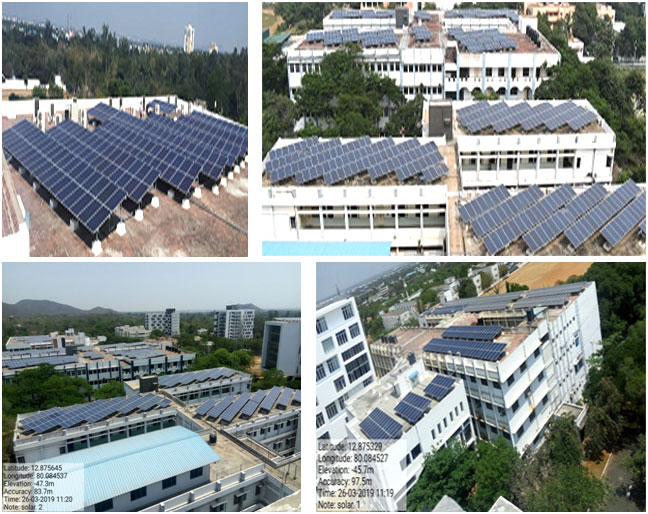
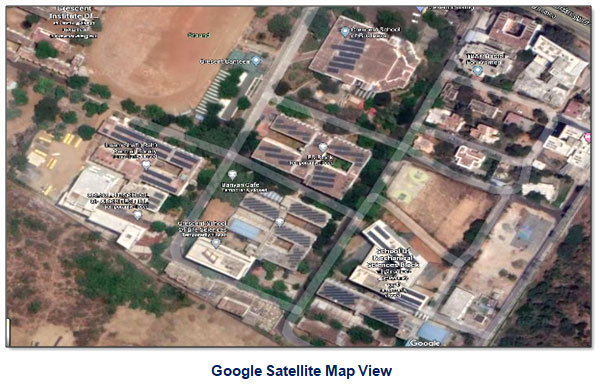
| S. No. | Year | Units Generated | Amount Saved in RS. | Units Generated | Amount Saved in RS. | Units Generated | Amount Saved in RS. |
|---|---|---|---|---|---|---|---|
| 150kWp | 100kWp | 300kWp | |||||
| 1 | 2014 | 1,03,248 | 8,77,615 | 17,458 | 1,48,398 | Installed during 2018 | |
| 2 | 2015 | 2,14,937 | 18,26,969 | 1,46,940 | 12,48,990 | ||
| 3 | 2016 | 2,05,374 | 18,42,140 | 1,50,730 | 13,56,665 | ||
| 4 | 2017 | 1,93,912 | 16,57,963 | 1,41,458 | 12,08,720 | ||
| 5 | 2018 | 1,98,162 | 17,12,369 | 1,50,464 | 13,00,737 | 41,037 | 3,74,495 |
| 6 | 2019 | 1,96,269 | 16,83,398 | 1,42,965 | 12,26,905 | 4,19,309 | 35,95,084 |
| 7 | 2020 | 1,81,064 | 19,52,642 | 1,29,606 | 13,95,243 | 2,98,201 | 31,55,265 |
| 8 | 2021 | 1,43,328 | 14,29,591 | 1,15,222 | 11,67,496 | 2,69,365 | 26,69,998 |
| Total | 14,36,294 | 1,29,82,687 | 9,94,843 | 90,53,154 | 10,27,912 | 97,94,842 | |
| New100kWp Solar PV Power Plant – Generation for one year 2021 | ||
|---|---|---|
| Month/Year | Units Generated | Amount Saved INR |
| Apr-21 | 12325 | 134096 |
| May-21 | 13358 | 152014 |
| Jun-21 | 11980 | 144838 |
| Jul-21 | 12325 | 128920 |
| Aug-21 | 12953 | 124608 |
| Sep-21 | 12508 | 114073 |
| Oct-21 | 11251 | 98671 |
| Nov-21 | 5255 | 48083 |
| Dec-21 | 11134 | 97645.2 |
| TOTAL | 103089 | 1042948.3 |
| Total Solar Power Generation – 650kWp upto 31st December 2021 | ||
|---|---|---|
| Plant | Units | Amount |
| 150Kwp | 14,36,294 | 1,29,82,687 |
| 100kWp | 9,94,843 | 90,53,154 |
| 300kWp | 10,27,912 | 97,94,842 |
| New 100kWp | 1,03,089 | 10,42,948 |
| Total | 35,62,138 | 3,28,73,631 |
The number of units generated through solar power plants constitute 16% of total electricity consumption since June 2014.
Renewable Energy – Solar Water Heaters
Installed total capacity of 36,500 liters. This is equivalent to 365 Nos electric geysers of 2kW capacities. The power saving is estimated to be around 24 Lacs per annum.

| Men’s Hostel | ||
|---|---|---|
| Block | No. of tanks | Capacity in liters |
| A Block | 20 | 5000 |
| B Block | 6 | 3000 |
| C Block | 6 | 3000 |
| D Block | 8 | 4000 |
| Main block | 20 | 5000 |
| PG block | 12 | 3000 |
| Ladies Hostel | ||
| Main block | 10 | 5000 |
| Annexure Block | ||
| New Block Phase 1 | 11 | 2750 |
| Staff Quarters | ||
| New Staff Quarters | 23 | 5750 |
| Total Capacity | 116 | 36,500Litres |
Renewable Energy – Solar Street Light
Installed towards staff quarters to Men’s hostel road and Architecture block area. This project was done by our III yr. EEE students along with our Estate electrical dept. team.

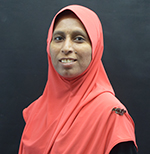
The Crescent Energy Club is a vibrant community of students, faculty, and professionals passionate about sustainable energy and its vital role in shaping our future. As an organization committed to promoting energy literacy and fostering a culture of sustainability, we invite you to join us on this exciting journey.
Our club serves as a platform for knowledge sharing, networking, and collaboration among individuals interested in energy-related fields. Through a wide range of activities and initiatives, we aim to empower our members to become leaders in the transition towards a clean and sustainable energy system. For more details: https://crescent.bytdigital.com/student-affairs/istd-clubs/crescent-energy-club
B.S. Abdur Rahman Crescent institute of Science and Technology received certificate for having actively participated in the IGEN GREEN DAY 2023 by taking Green action pledge and contributing towards the UN Sustainable Development Goals.
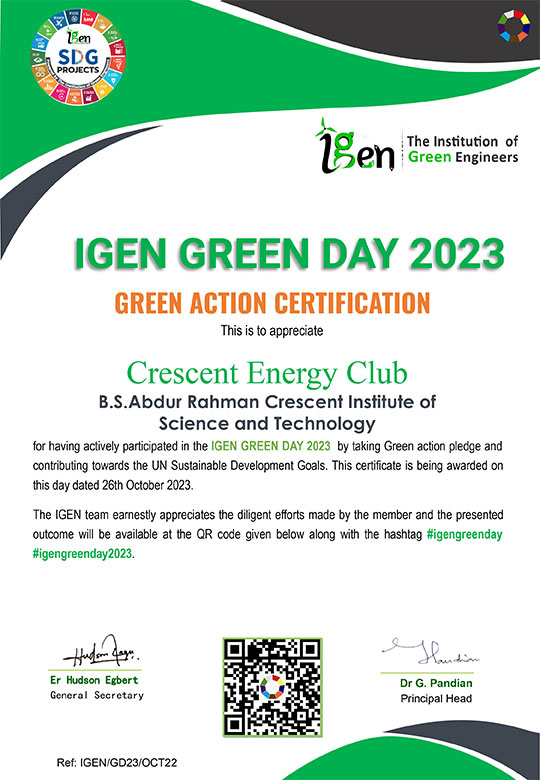
A workshop on climate change and its effect was conducted on 18.04.2022. It was organized by the Department of Electrical and Electronics Engineering in collaboration with IIT, Bombay. Prof.Chetan Singh Solanki, Prof./ IIT Bombay was the guest speaker. On one side, energy is the driver of our social and economic growth, while on the other side excessive use of fossil energy has caused climate change, which is becoming catastrophic and an threat to human existence. Since each one of us is a user of energy and hence contributor to climate change, each one of us must be part of the climate corrective actions. Adopting to Energy Swaraj or energy by locals for locals can be the solution to climate change, job creation, energy security and improving local economy. The speaker discussed philosophical, technical, economic, social, and environmental aspects of energy and climate change, along with a demonstration of the Energy Swaraj bus having facilities for working, meeting sleeping, cooking, washing, and training. The bus has the facilities to go through all daily activities. Energy Swaraj Yatra bus is demonstrated after the talk. The bus is fitted with 3.2 kW solar panels and 6 kWh of battery storage. It has a 3 kVa inverter. Lights, cooler, cookstove, TV, AC, laptop charging inside the bus are all solar-powered. The engine of the bus runs on diesel. The brochure highlighting the necessary information about the workshop was designed and circulated. A total of 40 faculty members and 500 students participated.
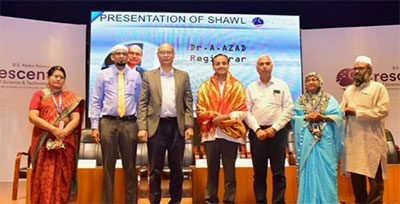
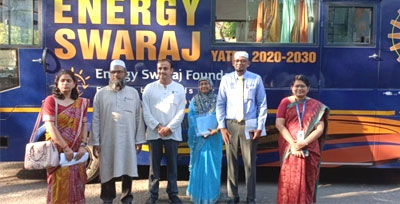
The Crescent Energy Club conducted an event for the Club named “ECOZEST‟ in our university premises. Mr.Gautham, CEO, “Walk for Plastic” was the Chief Guest for the Event. The team (Walk for plastic) collects plastics from surroundings, recycle it and use that money for the Education of Poor children. Dr. Karthikeyan Ramalingam, Professor/ SLS Dean (Student Affairs) & Chief Proctor (Discipline), Dr C Tharini, Dean/SECS and Dr R Jayashree, HoD/EEE felicitated the event and honored the chief guest with a memento and shawl. On that day, the Crescent Energy Club conducted the events namely Walk for Plastic rally, Quiz, Poster Designing and Connections in the field of Energy Conservation to create awareness among the students.
| S. NO | TITLE OF THE PROGRAM |
| 1 | “SDG ETHIOS’23” |
| 2 | SDG ARCEUS TALK SERIES 2 |
| 3 | IGEN GREEN DAY 2023 |
| 4 | COP 2030 VIRTUAL CONFLUENCE SESSION |
Academic Year 2020-21

REPORT ON PLANTING CEREMONY
On the occasion of 75th Independence Day
Report of the Event:
On the occasion of 75th Independence day, our institution organized an event on tree plantation in collaboration with Government of Tamilnadu and Social Work Team Trust (SWOTT). The District Collector and Magistrate was invited there as a chief guest. Our staff and students actively participated in the ceremony and carried out the plantation of palm seed in and around Thiruvalluvar District along with the volunteers of Social Work Team Trust (SWOTT) and Public Works Department. The ceremony started with prayer.
The program aimed to plant about 75000 palm seeds saplings in and around Thiruvallur district. The forestry coordinator guided students on how to sow seeds and plants. Teachers also participated in that event to help students. At first, we started to implant seedlings along the central road of the district and then along all sides of the main ground. After that, the students also planted in the local areas nearby. Some charts and banners were also designed by the students relevant to tree plantation. These posters were hung there to raise awareness in the people about the needs of tree plantations. Finally, the event ended with an plantation of seed to conserve the ecosystem.
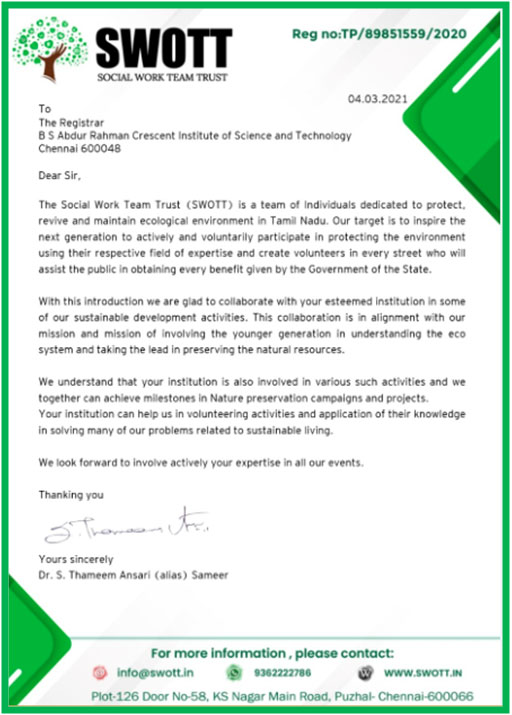
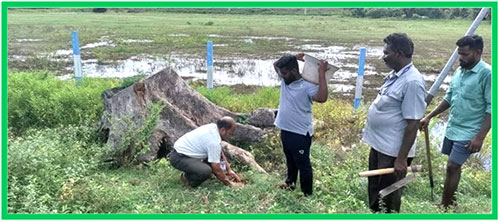

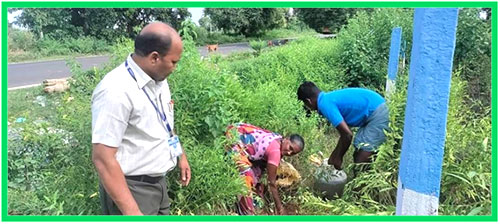


Police Commemoration Program – Tree Plantation Drive & Tribute to the Martyred Policemen

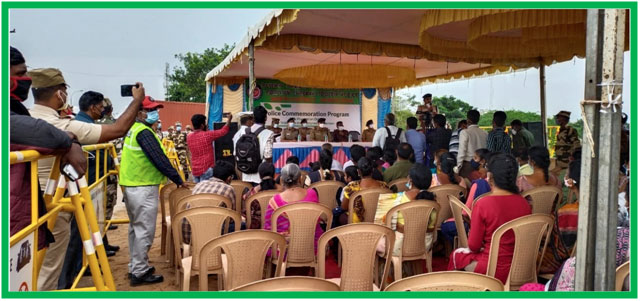
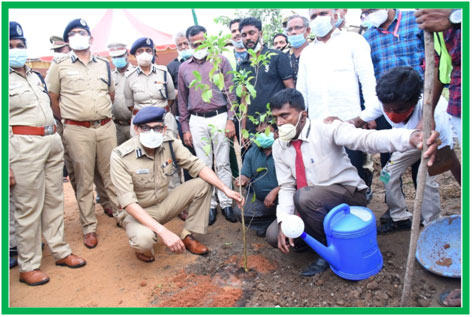
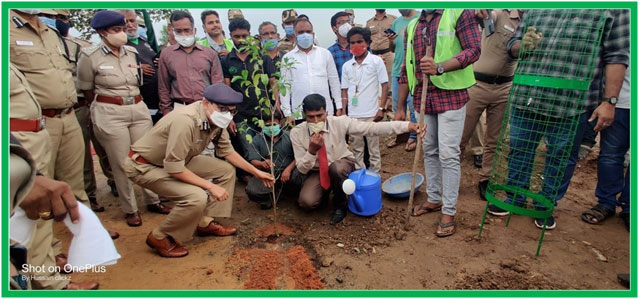
CENTRE FOR SUSTAINABLE DEVELOPMENT
Webinar talk during 14th National Conference on Indian Energy Sector, 3rd July, 2021
SAKET Projects Ltd, Gujarat has organized 14th National Conference on Indian Energy Sector – SYNERGY WITH ENERGY 2021 as webinar on 3rd July 2021 with the theme “India’s Energy Balance: From Energy Deficient to Energy Efficient & Energy Proficient Country” along with Gujarat Chamber of Coomerce, Ahmedabad. The first conference was inaugurated by Hon’ble Chief Minister of Gujarat and Special Address was delivered by Dr. A.P.J. Abdul Kalam, the then H.E. the President of India. The Recorded video of the webinar is available in the following Link:
https://www.facebook.com/saketprojectsltd/videos/185504303541669
SAKET Projects Ltd has invited Dr. T.Harinarayana, Director, CSD to participate as Chief Guest and give inaugural address. He has delivered talk on the following topics: Renewable Energy, Energy Efficiency and Innovation. He has shown Gujarat as examples for efficient use of resources to generate power. Gujarat has generated an ecosystem of power generation such as Solar Roof Top, Solar Canal Top, Solar Parks and Agri-solar etc.
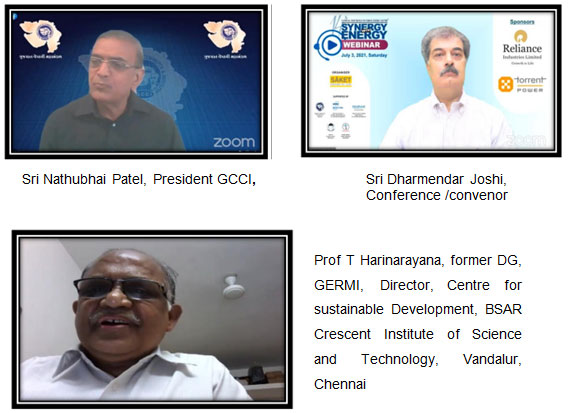
The Department of Electrical and Electronics Engineering had organized a Webinar on 09.02.2021 on the topic “Oil & Gas Conservation Awareness Drive GREEN & CLEAN ENERGY-SAKSHAM 2021”. The resource person was Mr. S Ramalingam, President, ENFUSE.
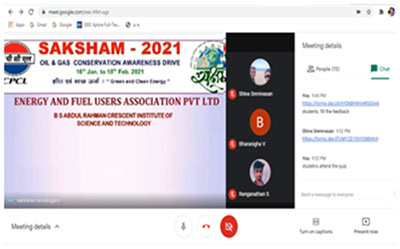
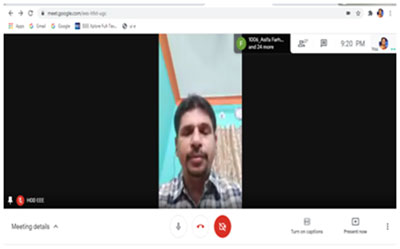
An awareness program on “Energy, Oil & Gas Conservation– Saksham 2022” was organized on 21.04.2022. Students of B.Tech (EEE), Research scholars and all the faculty members of EEE department participated in the event.
The guest speaker was Mr S Arockiya Antony is a gold medalist from Anna University and holds Master’s degree in petroleum refining and petrochemicals from Anna University in the year 2006. He is a BEE certified energy manager. He is currently working in Chennai Petroleum Corporation limited as Senior manager (production) taking care of Hydrocracking Unit. He has 15 years of experience in the field of hydrocarbon processing and has a strong knowledge base in the areas like Commissioning of process facilities, Hydrogen production facilities, Gasoline production unit, Refinery energy management, Process Modeling and Simulation, etc. He has excellent analytical/technical capabilities in Process unit problem identification and Troubleshooting. His areas of interest are Process simulation, Application of data analytics principles in the field of hydrocarbon processing, Application of artificial intelligence (AI) in the field of chemical engineering and green energy. Currently he is working on Identifying Artificial Intelligence (AI) application in Refining Industry and Refinery Energy Management through data analytics.
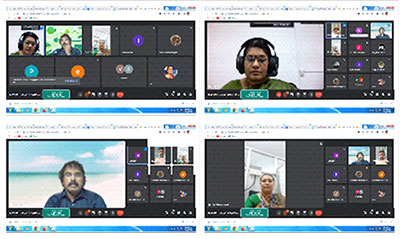
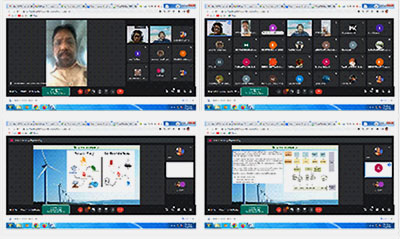
Department of Civil Engineering organized a webinar on “Green Built Environment – need of the hour” for the M.Tech. Structural Engineering students on May 26th, 2022 from 10.00 am to 11.00 am. Dr C. Velan, City Head – Chennai Operations & Pan India Head for Property Management at Ascendas India (Capitaland India) addressed the gathering. Students of M.Tech. Structural Engineering participated and got an exposure related to the importance of green buildings and cost benefits of green buildings.
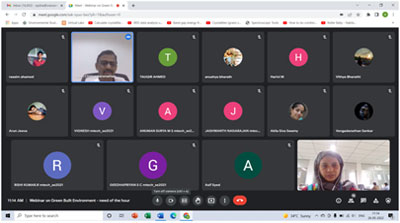
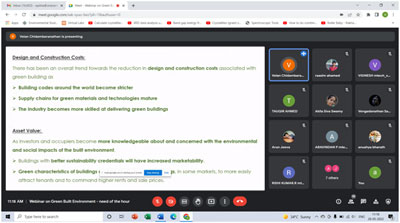
School of Infrastructure, Office of Students Affairs, and Crescent Rotract Club jointly organized an online webinar on “Impact of Solid Waste Management & Positive Effects of Source Segregation on an Individual & Community” by ‘MS. Ann Alexia Anra’ Sustainable Consultant, M/S Wasted 360 Solutions on 18.05.2022 at 2.30 P.M. Ann Alexia Anra shared her experience of recycling tetra packs, plastic waste, and cart board wastes into useful by-products like chairs, storage containers, tables, desks and chairs etc. She explained about the training given to local people to collect, segregate, process, and manufacture the chairs and storage boxes from the waste plastics and tetra pack threw in the dustbin and garbage. She presented on how to make home decorative products from the reused clothes and disposed waste clothes.
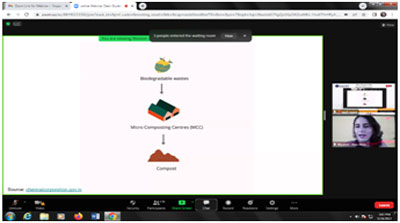
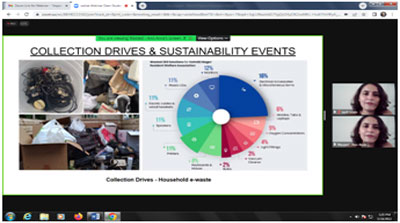
“BSACIST plays a crucial role in the promotion towards renewable energy sources through advocacy efforts. Our institution actively supports the commitment by arranging meetings with key stakeholders, and organizing events and discussions”
By signing on behalf of BSACIST, we are accepting a key role in fighting global injustice and committing our institution to a central and transformational role in attaining the Sustainable Development Goals (SDGs) by 2030. This commitment will look different for each institution, and we look forward to work and to achieve aspirational levels of sustainability for our students, staff and the wider community.
Together we can help create the next generation of change agents and redress the balance between people, planet and prosperity.
IMPLEMENTATION / OUTCOME
| Annual SDG Accord Report 2023 | SDG Accord Report 2023 |
 | SDG ACCORD Certificate |
| Green Action Certification – I-Gen | Green Action Certification |
| STAR World Record Ambassador | IGEN – Star World Record Ambassador |
| IGEN – Sustainability Best Practices Award | IGEN Energathon Certificate |
| IGEN – Star Contributor | IGEN – Star Contributor |
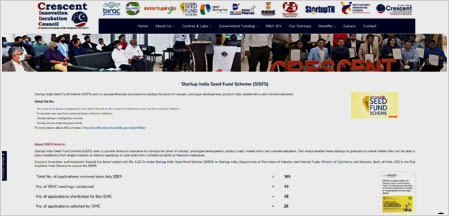
About SISFS Scheme
Startup India Seed Fund Scheme (SISFS) aims to provide financial assistance to startups for proof of concept, prototype development, product trials, market entry and commercialization. This would enable these startups to graduate to a level where they will be able to raise investments from angel investors or venture capitalists or seek loans from commercial banks or financial institutions.
Crescent Innovation and Incubation Council has been funded with Rs. 5.25 Cr under Startup India Seed Fund Scheme (SISFS) by Startup India, Department of Promotion of Industry and Internal Trade, Ministry of Commerce and Industry, Govt. of India. CIIC is the first incubator from Chennai to receive the SISFS.
| Total No. of applications received since July2021 | = | 365 |
| No. of ISMC meetings conducted | = | 10 |
| No. of applications shortlisted for the ISMC | = | 49 |
| No. of applications selected by ISMC | = | 26 |
| No. of startups for whom the sanction orders has been released | = | 23 |
| Total No. of funds been allocated for these23selected startups | = | Rs.500Lakh |
CIIC has successfully selected 17 startups after conducting 3 Incubator Seed Management Committee (ISMC) Meetings.
Sanction Order Release Ceremony
CIIC released 12 sanction orders with total sum of Rs. 2.5 Crore in the presence of V. Arun Roy IAS, Secretary, Department of MSME, Govt. of TN, Ms. Palak Bhatia, Senior Manager, Startup India, Govt. of TN and other dignitaries from BSACIST.
As part of Startup India Seed Fund Scheme (SISFS) due diligence, CIIC team visited M/s AloeEcell Pvt. Ltd established in Jaipur. CIIC has invested Rs.40 Lakhs on them.
These young determined founders and team is building the World’s first 100% ECO-FRIENDLY and NON-HAZARDOUS 1.5V AA size Aloe Vera Batteries which is 10% lesser cost and 1.5X more durability. They have made progress from R&D to finalising the MVP and design. They have been recognised and recommended in various national and international platforms. Soon they will be expanding the manufacture setup in Kota.

Academic Year 2020-21
A pledge taking ceremony for Eco-friendly and Green Campus was organised under NSS, Crescent Institute of Science and Technology on 14th Dec 2021. The pledge aims to accomplish the vision of “Energy Conservation”.
On National Energy Conservation Day we pledge our wholehearted commitment towards energy conservation in our daily lives.
“I promise to do my best to Energy Conservation:
close the door when I go in and out of the house
not stand and hold the refrigerator door open
turn off computers, monitors and games when not in use.”
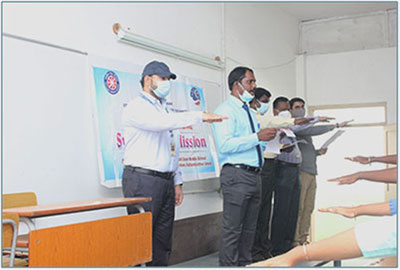
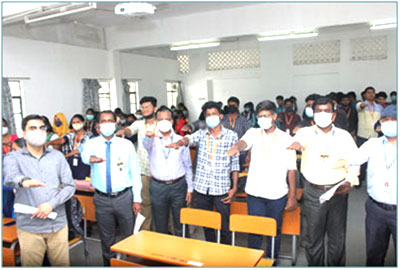
@Government School, Keerapakkam to accomplish the vision of “Energy Conservation”
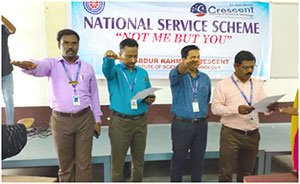
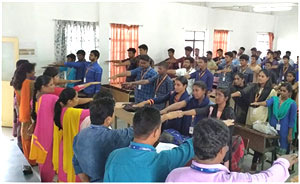
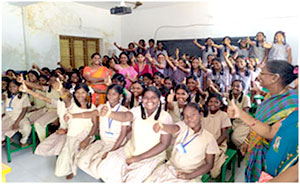
B.S. Abdur Rahman Crescent Institute of Science and Technology has an exclusive “Estate Office” for the maintenance of Building & Infrastructure facilities for the benefit of Students and Staff. Estate Office has a committed vision to ensure that the built infrastructure of the institute has sustainability as a core principle both in construction and maintenance management of the campus and it aspires to follow a range of sustainable design features and practices for implementing to build and maintain the institute as a complete green and sustainable campus continuously”.
- Energy and Water Conservation Measures
- Establish on campus renewable energy sources like Roof-top Solar Power Plants, water heaters, street lights and Bio-Gas plants.
- Green Belt Development
- Solid Waste Management program to separate recyclable waste and dispose all waste in non-polluting, responsible manner.
- Getting all buildings certified as Green buildings (Gold rating) under USGBC-LEED / GBCI-EDGE / IGBC rating systems.
- Follow Sustainable Construction practices.

Fact Sheet
| S.No. | CRITERION | |
|---|---|---|
| I | Renewable Energy – Solar Power Plant | |
| 1 | Roof-top Solar Power Plant I of 150kWp capacity commissioned in June 2014 at a cost of 1.32Cr. Return on Investment is 1.29Crore till 31st December 2021 | |
| 2 | Roof-top Solar Power Plant II of 100kWp capacity commissioned in October 2014 at a cost of 62Lacs. Return on Investment is 90.53 Lakhs till 31st December 2021 | |
| 3 | Roof-top Solar Power Plant III of 300kWp capacity commissioned in October 2018 at a cost of 1.20Cr. Return on Investment is 97.94Lakhs till 31st December 2021. | |
| 4 | Roof-top Solar Power Plant IV of 100kWp capacity commissioned in October 2020 at a cost of 40Lacs. Return on Investment is 10.42 till 31st December 2021 | |
| 5 | Total power generated through the Solar PV plants is 35,62,138 units till 31st December 2021, which is equal to 27% of our annual consumption of 2021 due to pandemic period | |
| 6 | Avoided emission of greenhouse gases to the equivalent of 21,23,051kg CO2 due to generation of renewable energy by Solar PV power plants from 2014 to 2021. | |
| Solar Street Light | ||
| 7 | Solar street lights 10 Nos provided near Architecture block and Staff quarters to Men’s Hostel. | |
| Solar Water Heater | ||
| 8 | Solar Water heaters in Hostels and staff quarters – installed capacity 36,500 liters. This is equivalent to 365 electric geysers of various capacities. The power saving is estimated to be around 24 Lakhs per annum. | |
| II | Solid Waste Management | |
| 1 | Solid Waste Management program is implemented – to segregate and recycle organic waste, paper, cartons, paper cups, soft drink tins, plastic, pet bottles, e-waste, bio-waste, etc. | |
| 2 | 250Kg Kankyo Eco bin installed in BSACIST campus for Food Waste collected from mess & kitchen. 30,735Kg Compost manure collected till July 2020 and used for landscaping. | |
| 3 | Garbage incinerator machine with 50kg/hr capacity installed in solid waste management yard for reducing waste product to inert ash. Daily generation 500kg/day and generated fly ash being used as manure around 22378 kg generated till December 2021. | |
| 4 | Sanitary incinerator with wet scrubber (for pollution control) is installed for disposing the napkins. Wet scrubber is attached at the outlet of burner fumes where the fumes gets scrubbed in water and gets filtered to remove the harmful emissions. | |
| 5 | Bio-gas plant of 50m3 capacity for Ladies Hostel is commissioned in June 2017. The gas generated is utilized in Ladies Hostel Kitchen. | |
| III | Liquid Waste Management | |
| 1 | Sewage Treatment Plant (STP) – 500KLD of water is treated and utilized for Landscaping and flushing purpose in the University and Hostels. One plant of 250 KLD capacity for Men’s Hostel and another 250 KLD capacity plant for University are in operation. | |
| 2 | Use of eco-friendly chemicals are mandatory for cleaning the campus | |
| IV | LED Fixtures & A/C | |
| 1 | LED fixtures – of around 86.31 KW capacity has been installed in all over campus in the past 6 years. By usage of LED, it is reduced around 70% of less power consumption. | |
| 2 | Passive Infra-red motion sensor lights provided in Computer Science block lab and staff cabin for energy savings | |
| 3 | Air-conditioning split units of 5-star BEE rating is installed in various departments in the campus for a total of 203TR. | |
| 4 | All the 203 split AC units are free from ozone-depleting CFC (Chlorofluorocarbons) | |
| V | Green Buildings & Certification | |
| 1 | All existing buildings are registered with Indian Green Building Council (IGBC) for green building certification under IGBC – EB rating | |
| 2 | New buildings are constructed over the last six years and those under construction are registered with GBCI EDGE and USGBC LEED for green building certification for Gold rating. | |
| 3 | GBCI-EDGE Green building certification received for New Ladies Hostel & New staff quarters on 23.04.2018. | |
| 4 | New Crescent School of Architecture block is conceived as a Net Zero Energy building and registered under USGBC-LEED for Gold rating certification. | |
| VI | Transport – Pollution Free Environment | |
| 1 | To reduce pollution inside campus, 55 Nos bicycles have been provided for students to commute between Men’s Hostel, Ladies Hostel and College Main gate. | |
| 2 | Retreading of vehicle tires to extend the life of each tier is being implemented with an MOU with TVS Retread. | |
| 3 | Battery Cars and Electric Bike provided for staff and Eco friendly Load vehicle for Hostel. | |
| 4 | 15 Nos new AC buses, which are BS-IV compliant vehicles, have been provided for induction into the student transport fleet from July 2018. | |
| VII | Carbon Foot Print and Carbon Offsetting | |
| 1 | 38% of Carbon foot print is offset by the above environment – friendly measures in campus and 10% Carbon Offsetting. | |
| VIII | Rain Water Harvesting | |
| All Buildings | ||
| XIV | Green Campus – Tree Plantation | |
| 1 | Planted Beema bamboo saplings for 5000sft run area throughout our compound to absorb dust, CO2 and to release more oxygen and to create pollution free environment. | |
| 2 | Oxy park created opposite to convention Centre by planting Beema bamboo in campus | |
| 3 | Trees (More Varieties) | 1019 Nos |
| 4 | Beema Bamboo Plants | 2075 Nos |
| 5 | Total No.of tree planted | 3094 Nos |
| XV | Certification & Ranking | |
| 1 | QS Star Rating for facilities | 5 Star |
| 2 | QS I.Gauge Audit for facilities | Diamond |
| 3 | All New Buildings | Edge certified |
| 4 | UGC Swachhta | 5th Rank |
| 5 | AICTE- Smart & Clean Campus Award | Appreciated |
| 6 | District Green Champion Certificate | |
| 7 | Recognized as Beat Covid Campaign Institution | |
| 8 | Recognized Social Entrepreneurship, Swachhta & Rural Engagement Cell (SES REC) Institution. | |
By reducing energy demand, India can lessen the pressure on its energy infrastructure and reduce the need to build new power plants, which often use fossil fuels. Cost-effectiveness: Energy efficiency measures generally have a lower upfront cost compared to building new renewable energy infrastructure.
| Guidelines issued by the GOI | https://powermin.gov.in/en/content/energy-efficiency |


Department of Civil Engineering organized a webinar on “Green Built Environment – need of the hour” for the M.Tech. Structural Engineering students on May 26th, 2022 from 10.00 am to 11.00 am. Dr C. Velan, City Head – Chennai Operations & Pan India Head for Property Management at Ascendas India (Capitaland India) addressed the gathering. Students of M.Tech. Structural Engineering participated and got an exposure related to the importance of green buildings and cost benefits of green buildings.


Academic Year 2020-21
Evaluation of Sacrificial Anode Cathodic Protection (SACP) Systems for Reinforced Concrete Applications
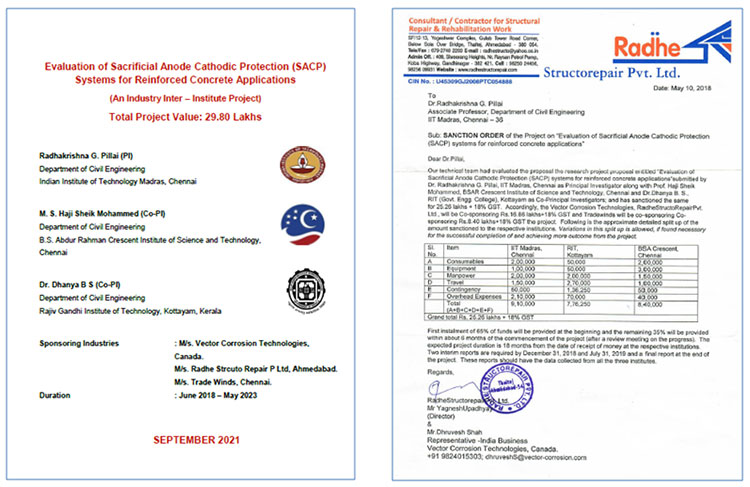

https://crescent.bytdigital.com/wp-content/uploads/2022/11/1.-SACP-Project-September-2021_V2.pdf
Structural Behavior of Corroding Prestressed Concrete (PSC) Systems and Extension of Service Life Using Cathodic Protection


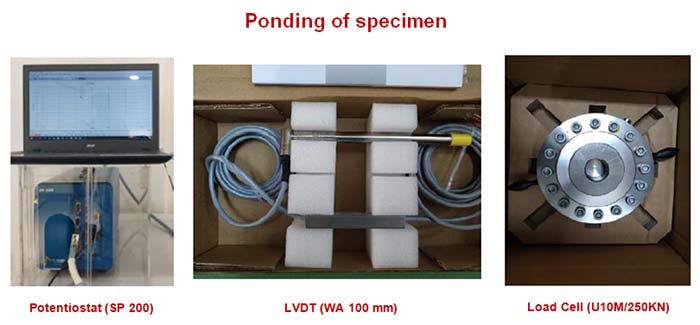
https://crescent.bytdigital.com/wp-content/uploads/2022/11/2.-DST-SERB-September-2021_V2.pdf
Corrosion Protection and Service Life Extension of Reinforced Concrete Roofing System in Existing Buildings
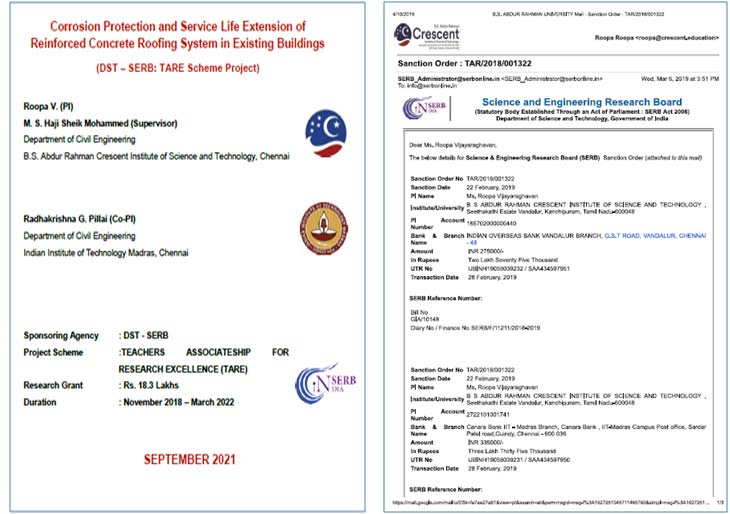
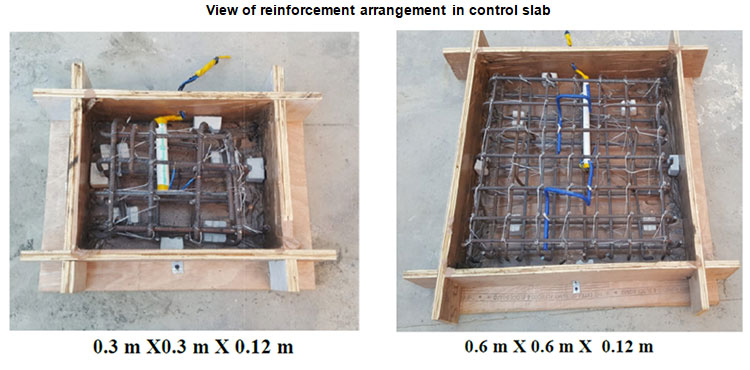
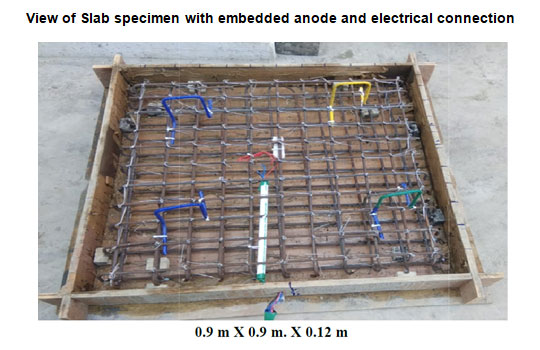
![]()
https://crescent.bytdigital.com/wp-content/uploads/2022/11/3.-TARE-Project-September-2021_V2.pdf
Inauguration of 45th Indian Social Science Congress in association with BSACIST

The inaugural ceremony of XLV Indian Social Science Congress held at B.S.Abdur Rahman Crescent Institute of Science and Technology (Deemed to be University) on March 28 10.00 AM at its Vandalur campus in Chennai. Environment, Energy and Health as its focal theme. The program was started with Tamil Thai Valthu.
Dr. T. Harinarayana, organizing secretary formally welcomed all the dignitaries present on the dais and participants from various parts of the country, colleagues & students. He mentioned about the significance of Indian Social Science Congress and its aims about bringing together a group of researchers from all over India. Prof. D. M. Diwakar, General Secretary Indian Social Science Academy, described the aim of the congress. He emphasized on the scientific inquiry is the solution for the entire problem in the society.
Following new publications were released during the inaugural function of XLV ISSC; 1. Human Future in Digital era (Chief Guest), 2. Social Science Abstract vol.45,2022 (President), 3. Souvenir of XLV Indian Social Science Congress (Chancellor)
Indian Social Science Academy Silver Jubilee P.V.Sukhatme Gold Medal is awarded to Sri P.Sainath for his outstanding contribution to scientific understanding and solutions of problems of hunger, perennial poverty, unemployment and sufferings of people of democratic republic of India. He thanked Indian Social Science Academy for giving this prestigious award in the name of P.V.Sukhatme famous Indian statistician and pioneer in applying random sampling methods in agricultural statistics and in biometry and influential in the establishment of the Indian Agricultural Statistics Research Institute.
The senior journalist of NDTV Ravish Kumar was awarded with ‘BASANT SARKAR GOLD MEDAL’ for upholding and promoting democratic values of equality, freedom and fraternity through honest and scientific journalism fearlessly and boldly. He also thanked Indian Social Science Academy for giving the prestigious award during the congress.
Prof. Dr. Mahadhavan Nair Rajeevan, the former Secretary of Ministry of Earth and Atmospheric sciences, Government of India inaugurated and delivered the inaugural address of the 45th Indian Social Science Congress. He congratulated the Social Science Academy and BSA Crescent Institute for choosing the focal theme Environment, Energy and Health. He focused on the importance of Social science in order to formulate effective solution for society. He said social science can play important role in the entire field by a multidisciplinary approach and social sciences and natural sciences are closely related. He suggested to Government of India to include and involve one social scientist in the big research projects by DST and CSIR.
Dr.G.Parthasarathy, President of Indian Social Science Academy gave his Presidential address on the topic of Minerals- Materials from Nature, and for Nature : Society, Environment and Energy/ Circular Economy. He began his talk by addressing the gatherings and spoke about ISSA and Chinese academy of sciences. He spoke about the Importance of Health by quoting the saying “ Noyatra Vaazhve Kuraivatra Selvam” and further he spoke about the circular Economy and health. He shared few examples from Mineral-World in improving the environmental (Health) conditions and improving the energy needs of our Nation. He said that our Mother Earth has about 4300 Mineral species. Bob Hazen coined the term “Mineral Evolution “. He used this term in the sense of an irreversible sequence of events leading to increasingly complex and diverse assemblages of minerals. He then spoke about Clay Minerals, especially a group of phyllosillicates of tetrahedral (T) and octahedral (O) has its applications in drug carrier and delivery, support for catalyst and fillers for polymeric matrices.
The inaugural function felicitated by Dr. A. Peer Mohamed, Vice Chancellor Dr. A. Azad, Registrar BSA Crescent institute of Science and Technology. In the end, Dr. Raja Hussain, Additional offered a vote of thanks to all the invited guests and participants for gracing the occasion by their solemn presence. He also thanked Indian Social science Academy for providing all kind of support to conduct such congress in the Crescent Institute.
Day – 1 (28.03.2022)
The 45th Indian Social Science Congress was successfully inaugurated on March 28th, 2022. On this historic occasion, the Indian Social Science Academy, as well as dignitaries from the B.S.Abdur Rahman Crescent Institute of Science and Technology, were present. publications were also released. Approximately 500 abstracts were received as a response of the outpouring support from our delegates across the country.
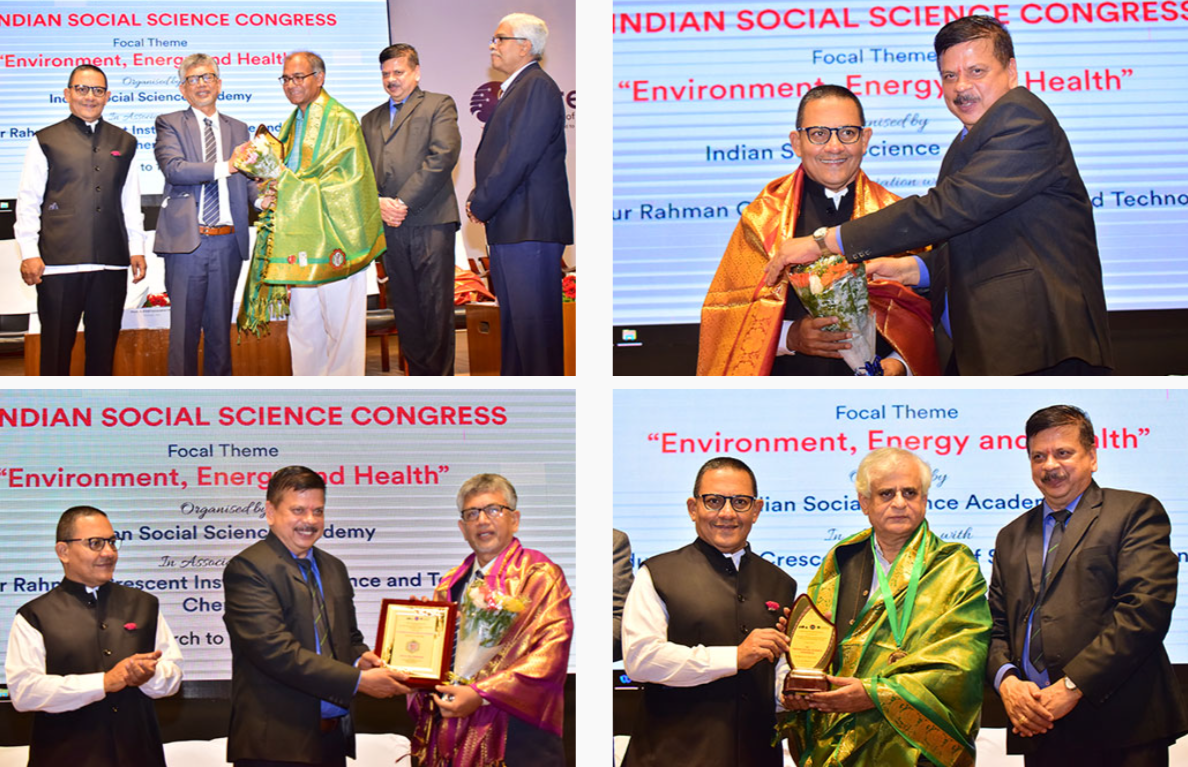
Day – 2 (29.03.2022)
Dr. Gufran Baig of the National Institute of Advanced Studies (NIAS), Indian Institute of Science (IISc) campus, spoke on the “Physics of Air Quality and Climate Change” which was a delightful start to the day. It was a truly eye-opening experience.

Dr.Rajinder Chaudhary, Former Professor, Dept. of Economics- MD University (Haryana), delivered a rousing address on how conventional farming adversely impacts the environment, energy, and health, suggesting to focus on self-reliant organic farming contributes to protection.


Parallel sessions on diverse topics are being held as national seminars and workshops at BSA Crescent Institute of Science and Technology as part of the 45th Indian Social Science Congress.

Day – 3 (30.03.2022)
It’s a magnificent day that began with a session on Sustainable Building Architecture by Dr.R.Velraj, Vice Chancellor – Anna University, Chennai.


Dr. Sankar Kumar Nath, Department of Geology & Geophysics, IIT Kharagpur, led a fascinating debate on Probabilistic Seismic Hazard Assessment of India.




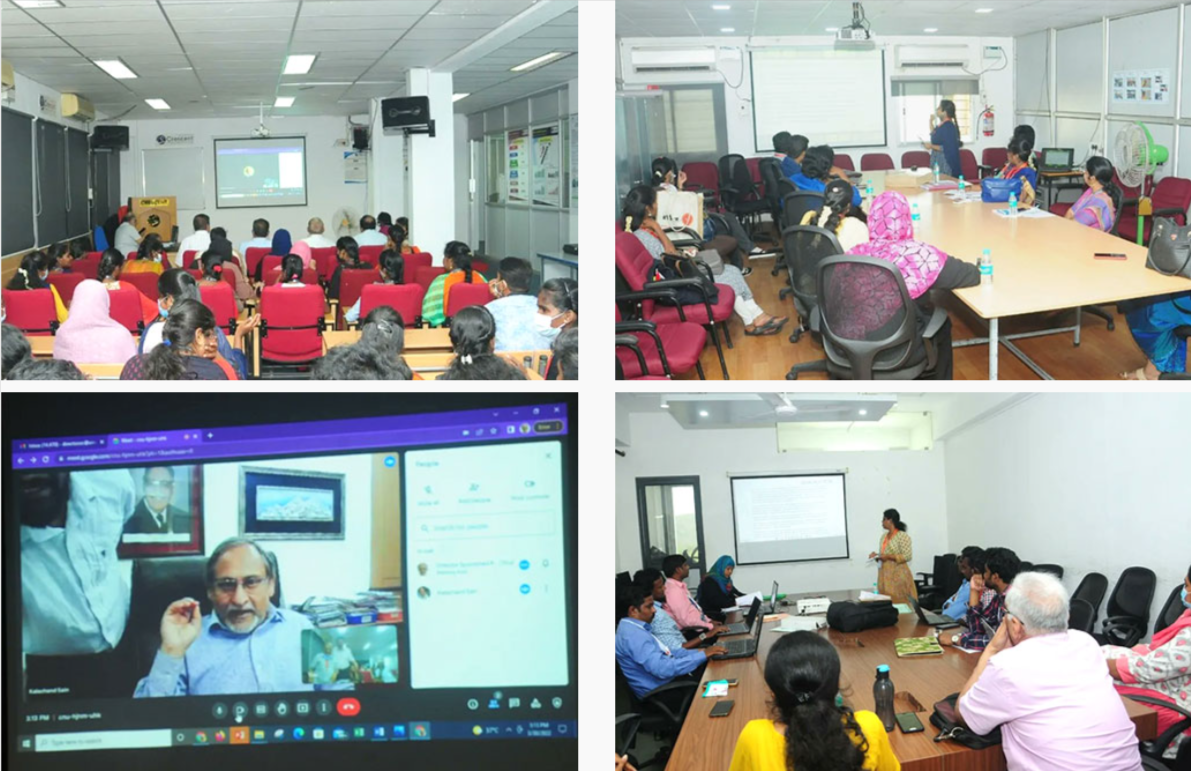

Day – 4 (31.03.2022)
It is a splendid morning with a dynamic speaker, Dr.A.Venu Gopal, Director, CSIR-NPI, Delhi who spoke on “Metrology for Societal Applications”




Day – 5 (01.04.2022)
Day 5 of the 45th Indian Social Science Congress began as tremendous like earlier with the flourishing speech of Dr. Jagannathan, Professor & Head – Dept.of NMR & MRI, AIIMS – New Delhi, On Role of MRI in Medicine and Healthcare.

Dr.Rana Pratap Singh, Director-IQAC & Dean – Academic Affairs, Central University, Lucknow led a fascinating talk on Converting Carbon Source into Carbon Sink



Workshop and Seminars – Energy Efficiency and Clean Energy
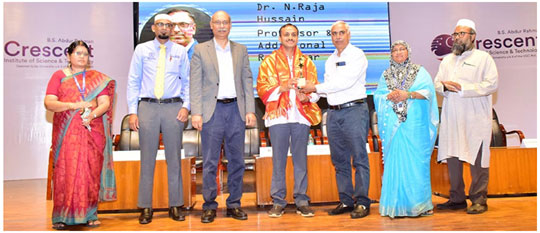
L to R: Dr.R.Jayashree, HOD-Electrical and Electronics Engineering Department, Dr.M.S.Haji Sheik Mohammed, Dean-Academics, Dr.A.Azad, Registrar, Prof. Chetan Singh Solanki, Professor, IIT – Bombay, Dr. N.Raja Hussain, Additional Registrar, Dr.D.Najumnissa Jamal, Dean-School of Electrical and Communication Sciences, Dr.S.Rasool Mohideen, Dean-School of Mechanical Sciences, B.S.Abdur Rahman Crescent Institute of Science and Technology, Chennai
Prof. Chetan Singh Solanki, Professor at IIT, Bombay visited B.S.Abdur Rahman Crescent Institute of Science and Technology Campus, Chennai on his 11-year-long Yatra on 18.04.22 and conducted a workshop on “CLIMATE CHANGE, ENERGY SWARAJ AND I”.
In the context of Energy Access, Energy Sustainability and Climate Change, Prof. Chetan S Solanki have coined the term Energy Swaraj . He works in establishing Energy Swaraj or providing localized solar energy solutions across the globe by developing solar PV technologies and products, developing and conducting training on solar PV technologies and products, planning and executing large scale projects, particularly in the off-grid energy sector, monitoring the impact and conducting research. He is also interacting with policy makers and providing inputs in policy making. He has been recently conferred with the title of Brand Ambassador of Solar Energy for Govt. of Madhya Pradesh.
During his yatra, which began in November 2020 from Mumbai, he has been creating a public movement towards 100% adoption of solar energy. The ‘solar bus’ reached Chennai after covering 18,000 km across nine states. Prof. Solanki’s ‘mobile home’ is equipped with 3.2 kW solar panels and 6 kWh of battery storage. It also has a 3 kVA inverter. The bus runs on diesel, but all lights, cooler, cookstove, and other appliances inside it are solar-powered.
For switching fully to solar energy, Prof. Solanki advises a three-step approach—’Avoid, Minimise and Generate’. “Avoid use of energy as much as possible even if it is solar energy. If you can’t avoid the use of energy, minimise its use through use of efficient appliances. And, generate energy locally. Energy Swaraj is about distributed production, and its Energy by Locals for Locals” he said. Prof. Solanki undertook the Energy Swaraj Yatra after an international trip convinced him that very little was being done constructively to mitigate global warming. But for ‘Energy Swaraj’ to succeed, government action alone would not suffice, he said. Underscoring the importance of energy literacy, he said individuals and institutions would have vital roles in it.
An awareness program on “Energy, Oil & Gas Conservation– Saksham 2022” was organized on 21.04.2022. Students of B.Tech (EEE), Research scholars and all the faculty members of EEE department participated in the event.
The guest speaker was Mr S Arockiya Antony is a gold medalist from Anna University and holds Master’s degree in petroleum refining and petrochemicals from Anna University in the year 2006. He is a BEE certified energy manager. He is currently working in Chennai Petroleum Corporation limited as Senior manager (production) taking care of Hydrocracking Unit. He has 15 years of experience in the field of hydrocarbon processing and has a strong knowledge base in the areas like Commissioning of process facilities, Hydrogen production facilities, Gasoline production unit, Refinery energy management, Process Modeling and Simulation, etc. He has excellent analytical/technical capabilities in Process unit problem identification and Troubleshooting. His areas of interest are Process simulation, Application of data analytics principles in the field of hydrocarbon processing, Application of artificial intelligence (AI) in the field of chemical engineering and green energy. Currently he is working on Identifying Artificial Intelligence (AI) application in Refining Industry and Refinery Energy Management through data analytics.


The Department of Electrical and Electronics Engineering had organized a Webinar on 09.02.2021 on the topic “Oil & Gas Conservation Awareness Drive GREEN & CLEAN ENERGY-SAKSHAM 2021”. The resource person was Mr. S Ramalingam, President, ENFUSE.


A guest lecture was organized by the Department of Civil Engineering, School of Infrastructure in association with the American Society of Civil Engineers, Society of Civil Engineers and Indian Concrete Institute on 18.4.2022 at 10 am. The guest speaker Er. G. Jayarajan, Superintending Engineer/Civil at Udangudi Thermal Power Project – TANGEDCO and Vice President, TNEBEA delivered a lecture on the topic “An overview of Asia’s longest coal jetty at Udangudi 2X660MW super critical thermal power project”.
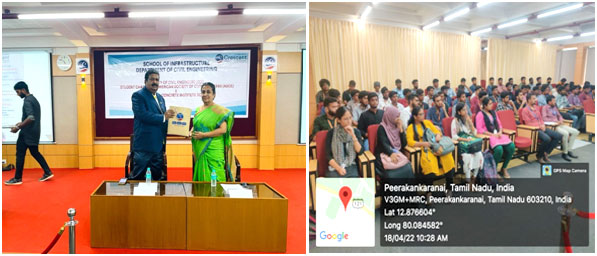
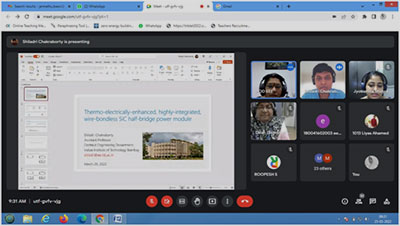
An expert lecture on “Thermo electrically enhanced highly integrated wire bondless SiC half bridge power module” was organized by the Department of EEE of B.S.Abdur Rahman Crescent Institute of Science and Technology on 25.3.2022 at EEE Department Seminar Hall for the benefit of the B.Tech and M.Tech students, faculty members and research scholars. Dr. Shiladri Chakraborty, Assistant Professor, Department of Electrical and Electronics Engg, Indian Institute of Technology, Bombay delivered the lecture. Dr.Jyotismita Mishra AP/EEE and Dr S.Jennathu Beevi Assistant Professor (Sr.Grade)/EEE organized the expert lecture. Around 60 participants comprising of UG and PG students, faculty members and Ph.D. scholars have participated the seminar.
The Department of Electrical and Electronics Engineering had organized a Webinar on 18.07.2020 on the topic “Distribution of Power From Practical Perspective”. The resource person was Dr. Mohamed Ismail, Manager- HV Distribution, Connection Services Department, Distribution power division, Dubai Electricity and Water Authority (DEWA).


Dr. Adhi Narayanan Theerthamalai (Alumnus EEE), Lead Electrical Engineer & Power Systems Study Specialist, Petrofac International Ltd, UAE

Dr. Mohamed Ismail (Alumnus EEE), Manager- HV Distribution, Distribution Power Division, Dubai Electricity and Water Authority (DEWA)

Mira Carb STP, Vermi Filter, PyroCraker & Biobox Biogas@ CRESCENT Installed by M/s. Kankyo CleanTech Pvt. Ltd, Under Institute – Institute Cooperation.
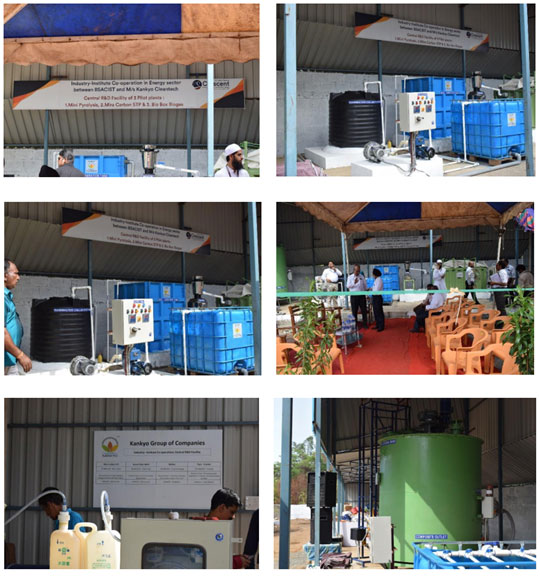
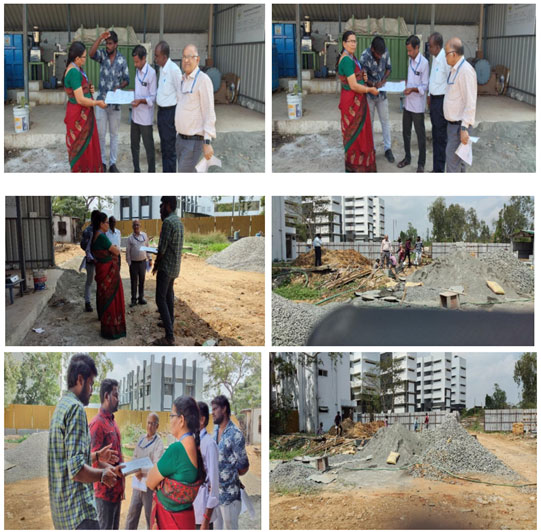
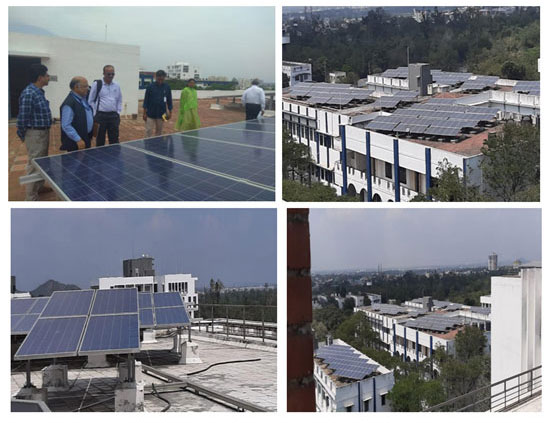
| S. No | Funding Agency | Website | Contact Details |
|---|---|---|---|
| 1 | Atomic Energy Regulatory Board (AERB) | http://www.aerb.gov.in/ | Atomic Energy Regulatory Board Niyamak Bhavan, Anushaktinagar, Mumbai Tel: 22-25990100 Fax: 22-25583230 Email:webmaster@aerb.gov.in |
| 2 | Centre for Wind Energy Technology (CWET) | http://niwe.res.in/ | The Director,National Institute of Wind Energy, Pallikaranai, Chennai Tel: 044-22463982 / 22463983/29001167 Fax : 044-2246 3980 |
| 3 | Department of Atomic Energy (DAE) | http://www.dae.nic.in/brns | The Scientific Secretary (BRNS), Department of Atomic Energy, Directors office, Ist Floor, Central Complex, BARC, Mumbai- 400 085. Tel: 91-22-25590813 Fax: 91-22-25505050 e-mail: brns@barc.gov.in |
| 4 | Department of Non Conventional Energy Sources (DNES) | http://www.mnre.gov.in | The Secretary, Department of Non Conventional Energy Sources, Block No. 14, CGO Complex, Lodhi Road, New Delhi, 110003 e-mail: aktripathi@nic.in Fax: 011- 24362772/24361298 Tel: 24361481/24362772 |
| S. No | Name of the Project | Name of the Principal Investigator | Name of Funding Agency | Department | Funds Provided (In Lakhs) | Duration |
|---|---|---|---|---|---|---|
| 01 | Light induced process of Hierarchical electron cascade system, Materials and Devices for Solar energy conversion | Dr. Asha Jhonsi Mariadoss | Science and Engineering Research Board (SERB) | Chemistry | 18.30 | 3 Years |
Student Projects related to Renewable Energy options

Dhivya.P, Ganapathy Sivam.C, Madhumitha.S, Javid Nazeem.A
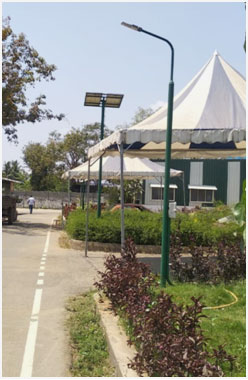
B.Aravindh, A.Juneeth Alam, P.Nanda Kumar, M.Ashfaaq Ali Ahamed
| S. No | Course Code | Course Details |
|---|---|---|
| 1 | PTEEC2103 | Generation, Utilization and Conservation |
| 2 | PTCHB2181 | Environmental Science and Engineering |
| 3 | PTEECX05 | Smart Power Grid |
| 4 | PTEECX06 | Wind Energy Conversion Systems |
| 5 | PTEECX07 | Flexible AC Transmission System |
| 6 | PTEECX11 | Solar Energy Technology |
| 7 | PTEECX16 | Energy Auditing |
| 8 | PTEECX27 | Power Electronics Application to Renewable Energy Systems |
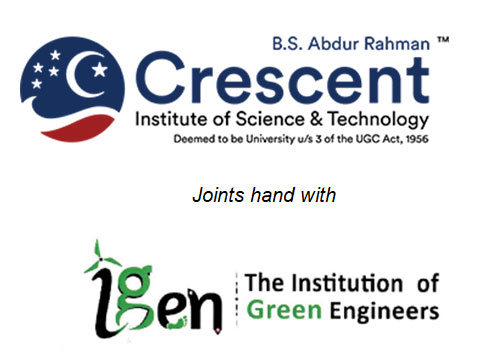
The Faculty members of BSACIST are encouraged to inform and support Government and NGOs in Clean Energy and Energy – Efficient technology to help the community to return to renewable energy sources and to reduce environmental impacts. In line with that, BSACIST joints hand with IGEN – The Institution of Green Engineers (IGEN) to connects green professionals worldwide, working towards SDG goals and providing solutions for a sustainable greener future through the 9 colour nonagon VIBBGGYOR society.
IGEN – Serve as a catalyst to connect all professionals for building a greener world.
To bring together all the professional practitioners working for creating a green community. To provide sustainable environmental solutions to achieve a green world. To inspire, inform and influence the global engineering community to adopt green engineering practices in their design, product, process and systems. https://www.theigen.org/
Report on IGEN ENERGATHON 2023 – Setting a New World Record and Achievements
Introduction
This report provides an overview of the successful IGEN ENERGATHON 2023 Conference, a prestigious event in the field of energy and sustainability. The conference, focused on clean and sustainable energy solutions, brought together experts, researchers, industry leaders, and students to engage in discussions and explore various aspects of affordable and clean energy. This report highlights the conference’s accomplishments, including the awards received by B.S. Abdur Rahman Crescent Institute of Science and Technology and the notable contributions of individuals from our institution.
Conference Details
The IGEN ENERGATHON 2023 Conference, held in Indian Standard Time (IST), featured an exciting schedule of sessions and activities. The event served as a platform for meaningful discussions, collaborations, and the exchange of valuable insights in the field of clean and renewable energy. Marathon started at 06:45 AM on 27th May 2023 and ended at 01:30 AM 28th May 2023.
The YouTube videos with 18 sessions are available in the following links.
Part I @ https://www.youtube.com/watch?v=f6r8WPrfup8&t=7s
Part 2 @ https://www.youtube.com/watch?v=Q7EFgOsSh8s&t=2s
ACHIEVEMENTS
B.S. Abdur Rahman Crescent Institute of Science and Technology received the following awards at the IGEN ENERGATHON 2023 Conference:
IGEN SUSTAINABILITY BEST PRACTICE AWARD
This award recognizes our institution’s successful demonstration of best practices, policies, and a strong commitment to attaining SDG 7 and its related UN Sustainability Goals. The Best Practices adopted by our institution were presented during the 19.13-hour marathon conference, showcasing our dedication to sustainable energy solutions.
IGEN STAR Contributor
Our institution’s speakers participated in the “UNITED NATION GLOBAL REPORTS PRESENTATION” session, contributing to the representation of #SDG7 during the conference. This award acknowledges their valuable contributions to the discussions on clean and affordable energy.
IGEN ENERGATHON STAR AMBASSADOR Certification
Our institution’s active participation resulted in more than 100 participants representing our institution, earning us the IGEN ENERGATHON STAR AMBASSADOR CERTIFICATION. This certification recognizes our commitment and enthusiasm for promoting sustainable energy solutions.
Individual Contributions
Several individuals from our institution made noteworthy contributions to the IGEN ENERGATHON 2023 Conference:
Dr. R. Jayashree, Professor and Head of the Department of Electrical and Electronics Engineering, received the IGEN Ambassador Award for her notable contributions.
Dr. S. Jennathu Beevi, AP(Sel.Gr)/EEE Energy Club Coordinator of BSACIST, participated as a speaker in the “Organizer Institution – Global Energy Reports Presentation” session and the “SDG7 Action / Best Practices Presentation” session. Dr. S. Jennathu Beevi received the Speaker Award for both sessions.
Dr. R. Zahira, AP(Sr.Gr) , played a vital role as the overall Organizing Head and Committee Member of the IGEN ENERGATHON 2023 Conference. Dr. R. Zahira’s significant contributions led to the successful celebration of the conference in alignment with the United Nations SDG7. Furthermore, her efforts in creating a new world record for the Non-Stop, online Conference on SDG7 Affordable and Clean Energy towards Sustainability were recognized with the Star Organizer and Contributor Awards. https://www.linkedin.com/in/drrzahira/
Dr. S. Suresh, AP(Sel.Gr)/EEE, organized one of the sessions at the IGEN ENERGATHON 2023 Conference and received the Organizer Award for his valuable efforts.
Dr. K.R. Shanmuga Vadivu, Assistant Professor, received the IGEN Ambassador Award.
Conclusion:
The IGEN ENERGATHON 2023 Conference served as a platform for knowledge sharing, collaboration, and promoting sustainable energy solutions. B.S. Abdur Rahman Crescent Institute of Science and Technology’s notable achievements and contributions to the conference were acknowledged through multiple awards and certifications.
Mr. Shoaib, Ms. Ayesha Sithika from the second year of the Electrical and Electronics Engineering (EEE) department, along with Vikram Venkat from the final year of the EEE department, actively volunteered for the event and were honored with the IGEN Volunteer Certificate.
Furthermore, over 100 students from our institute enthusiastically participated in this historic world record event and were awarded certificates of participation, recognizing their valuable contribution.
The valedictory function of the IGEN ENERGATHON 2023 winners can be accessed through the link provided below.
https://www.youtube.com/watch?v=HtgD73L24n0&t=5584s
Dr. Karthikeyan Ramalingam, Professor, Dean (Student Affairs) & Chief Proctor gave a acceptance speech in the valedictory function conducted on June 27th, 2023 via Zoom.
SNAPSHOTS
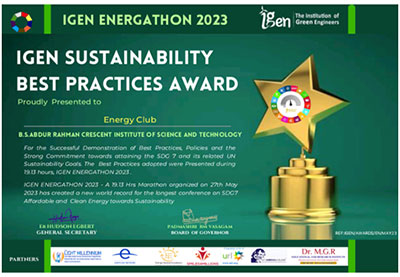
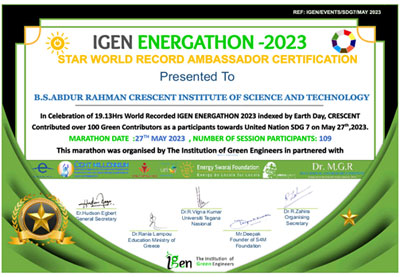
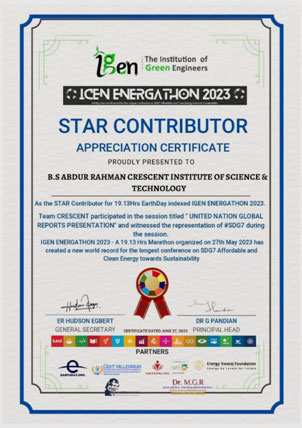
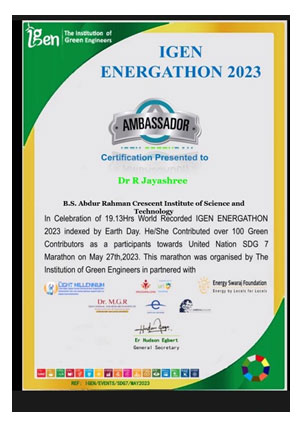
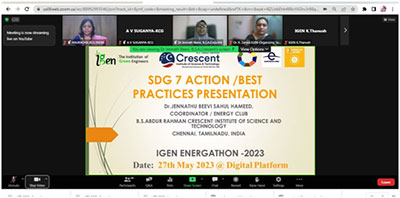
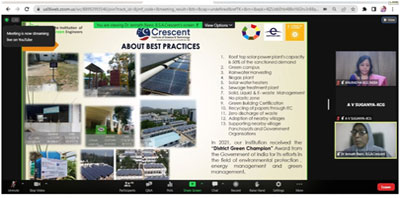
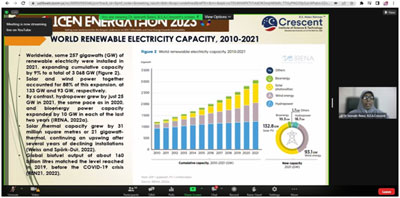
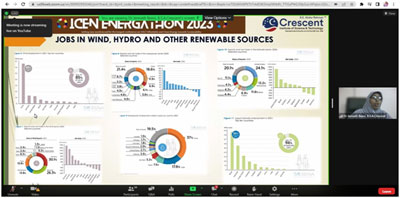

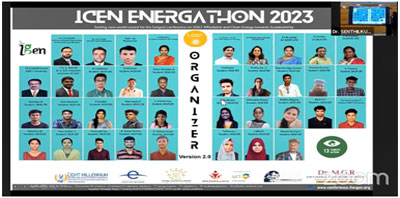
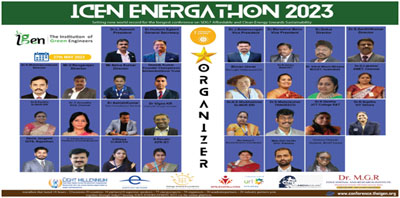
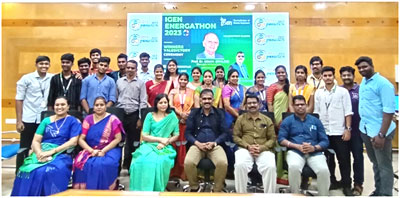
Academic Year 2020-21

Responsible Executive: Director (IQAC)
Responsible Office: Internal Quality Assurance Cell, Estate Office, and SDG Cell
Contacts: Registrar, Director (IQAC)
7.1 STATEMENT OF POLICY
- Ensure universal access to affordable, reliable and modern energy services
- In crease substantially the share of renewable energy in the global energy mix
- Double the global rate of improvement in energy efficiency
- Enhance international cooperation to facilitate access to clean energy research and technology, including renewable energy, energy efficiency and advanced and cleaner fossil-fuel technology, and promote investment in energy infrastructure and clean energy technology
- Expand infrastructure and upgrade technology for supplying modern and sustainable energy services for all in developing countries, in particular least developed countries, small island developing States, and land-locked developing countries, in accordance with their respective programmes of support
Inauguration of “Continuous Ambient Air Quality Monitoring Station (CAAQMS)”
Tamilnadu Pollution Control Board & B.S.Abdur Rahman Crescent Institute of Science & Technology Jointly organized and implemented Continuous Ambient Air Quality Monitoring Station (CAAQMS) in the Campus on 28th October 2020.
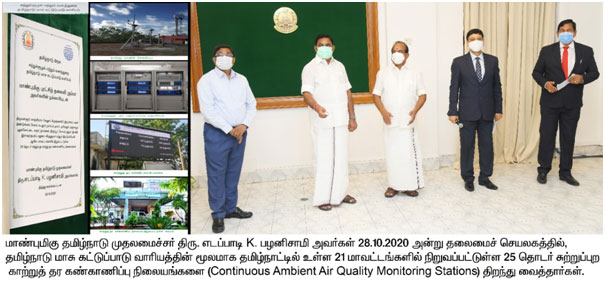
The Project was inaugurated by Mr. D.Vasudevan, District Environmental Engineer, Tamilnadu Pollution Control Board and Dr. A.Peer Mohamed, Pro Vice Chancellor & VC – In Charge. Dr. A.Azad, Registrar, AlhajV.N.A.Jalal, Senior General Manager, Dr. N.Raja Hussain, Deputy Registrar took part in the inauguration.
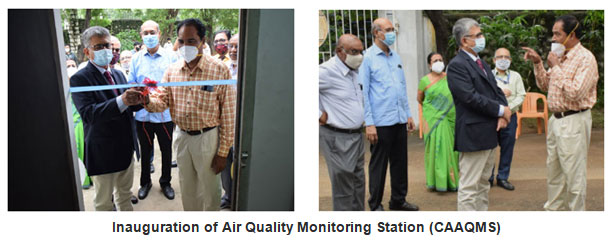
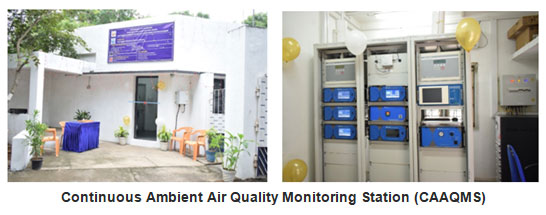

About SISFS Scheme
Startup India Seed Fund Scheme (SISFS) aims to provide financial assistance to startups for proof of concept, prototype development, product trials, market entry and commercialization. This would enable these startups to graduate to a level where they will be able to raise investments from angel investors or venture capitalists or seek loans from commercial banks or financial institutions.
Crescent Innovation and Incubation Council has been funded with Rs. 5.25 Cr under Startup India Seed Fund Scheme (SISFS) by Startup India, Department of Promotion of Industry and Internal Trade, Ministry of Commerce and Industry, Govt. of India. CIIC is the first incubator from Chennai to receive the SISFS.
| Total No. of applications received since July2021 | = | 365 |
| No. of ISMC meetings conducted | = | 10 |
| No. of applications shortlisted for the ISMC | = | 49 |
| No. of applications selected by ISMC | = | 26 |
| No. of startups for whom the sanction orders has been released | = | 23 |
| Total No. of funds been allocated for these23selected startups | = | Rs.500Lakh |
CIIC has successfully selected 17 startups after conducting 3 Incubator Seed Management Committee (ISMC) Meetings.
Sanction Order Release Ceremony
CIIC released 12 sanction orders with total sum of Rs. 2.5 Crore in the presence of V. Arun Roy IAS, Secretary, Department of MSME, Govt. of TN, Ms. Palak Bhatia, Senior Manager, Startup India, Govt. of TN and other dignitaries from BSACIST.
As part of Startup India Seed Fund Scheme (SISFS) due diligence, CIIC team visited M/s AloeEcell Pvt. Ltd established in Jaipur. CIIC has invested Rs.40 Lakhs on them.
These young determined founders and team is building the World’s first 100% ECO-FRIENDLY and NON-HAZARDOUS 1.5V AA size Aloe Vera Batteries which is 10% lesser cost and 1.5X more durability. They have made progress from R&D to finalising the MVP and design. They have been recognised and recommended in various national and international platforms. Soon they will be expanding the manufacture setup in Kota.

Academic Year 2020-21
Company Description
Company Name : MOSAIQUE PVT LTD
Website : mosaique.link
Vision
Our company Mosaique Pvt Ltd moves forward with the vision of “Try, Innovate and Change” by using the latest technologies and engineering concepts to solve environmental and social issues.
Mission
The Mission of Mosaique Pvt Ltd is to create a sustainable economy with the following mottos of:
- Improvement and protection of the environment
- Delivering the fully customised products according to user need
- Improving the living standards of people with continuous R&D
Verticals
- Waste Management using Subcritical Water Technology
- Retrofitting of Electric vehicles
- 3D- Printed Prosthetic arm for people with locomotor disability.
- Development of Air Purifier to eradicate harmful viruses.
Problem statement
- Non-Bio -degradable plastic wastes form the major part of Municipal Solid Wastes in major cities in India.
- Sorting and disposal of these kinds of wastes is one of the issues.
- To decompose the non-bio-degradable plastic waste there were several techniques followed like pyrolysis, hydrolysis, glycolysis, methanolysis and mechanical recycling.
- These traditional methods involve high cost and release harmful chemicals and gases.
Solution
Depolymerizing Plastic wastes using Subcritical Water Technology (SCWT) solves these issues due to following characteristics.
- SCWT uses water as a solvent which is environmentally friendly.
- Less expensive installation.
- Non flammable and explosive process.
- No organic residues at the end.
- SCWT process eliminates the issue of sorting and disposal of wastes as assorted wastes can be treated using this method.
Subcritical Water Technology
- Subcritical water is liquid water under pressure at temperatures above usual boiling point, 100 °C (212 °F).
- It is also known as “pressurized hot water”.
- At subcritical state, water is maintained in liquid form by applying pressure.
- The liquid water is in equilibrium with the vapor at saturated vapor pressure.
Properties that change in subcritical water
- Solvating power
- Viscosity
- Surface tension
- Dielectric constant
- Diffusivity
- Self- ionization
- Solvent volume
- Dielectric constant
Plot of pressure vs temperature showing various states of water – sub critical state is seen at 22. 1 MPa and 374 deg C
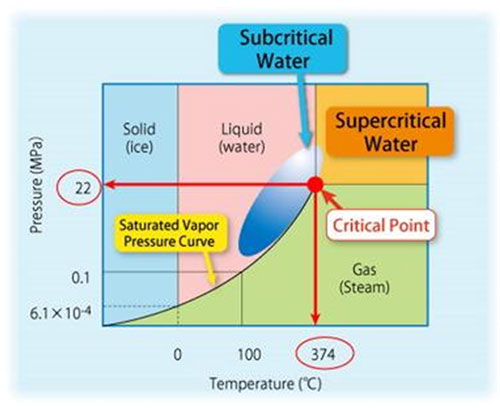
Why subcritical water ?
- Subcritical water can act as alternatives to polar liquids and semi polar solvents like ethanol, methanol and acetone.
- Production of green solvent with nil toxicity.
- No residual organic solvents at the end
- Less expensive installation.
- Non- flammable and non -explosive process.
- Usage of high temperature to modify the properties of water.
Applications of subcritical water extraction
- Insoluble fibres extraction like cellulose and lignin.
- Extraction of anti- oxidant molecules.
- Proteins extraction.
- Liquid chromatography
Extraction Principle of subcritical water technology
- This extraction method uses the new properties of water, at subcritical state which enable the solubilization of less polar compounds.
- The more the temperature increases, the more the polarity decreases.
Two modes of subcritical water extraction process are:
Static Mode
- The raw material is wetted with ambient water.
- Then, the mixture is subjected to high pressure and high temperature followed by cooling with emptying of the liquid phase which contains the interest molecules.
Dynamic mode
- The raw material is introduced into a pressurized vessel.
- Steam from preheated water is transferred and percolates through this fixed bed, dissolving and carrying with it interest molecules.
Comparison of Sub Critical Water Technology with traditional incineration
| Parameters | Incineration | Subcritical Water technology (Hydrothermal Depolymerisation) |
|---|---|---|
| Type of process | Burning of wastes at High Temperature | Treating waste with High temperature and pressure water. |
| Volume reduction | 90% of its volume | 70% of its volume |
| Types of wastes to be processed | Almost all organic wastes.(excluding green wastes) | Almost all organic wastes (Including green wastes) |
| Environmental Impact | Air pollution, greenhouse effect | No possible pollution |
| Pollutants | Dioxins, Acid gases, Nitrogen Oxide, Heavy Metals, Particulates. | No Dioxins, No Harmful gases are released |
| Guarantee of repair | 2 years | 10 years |
| Cost efficiency | 600 million yen | 315 million yen |
| Health problems | Respiratory diseases, Carcinogenic diseases (Cancer) | No effect on health problems. |
Our Aim
To design, develop and manufacture an equipment that uses subcritical water technology for decomposition of non bio- degradable plastic wastes into useful energy based products.
Our Equipment

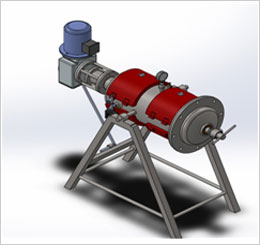
Future Efforts
- Efforts to reduce the time taken for decomposition of plastics.
- Preventive measures to arrest the release of harmful gases.
- Warning indicators for the reactor vessel when vessel conditions exceeds above or below the required level.
- Customising the equipment design and making it portable as per customer requirement.
Agreement

![]()
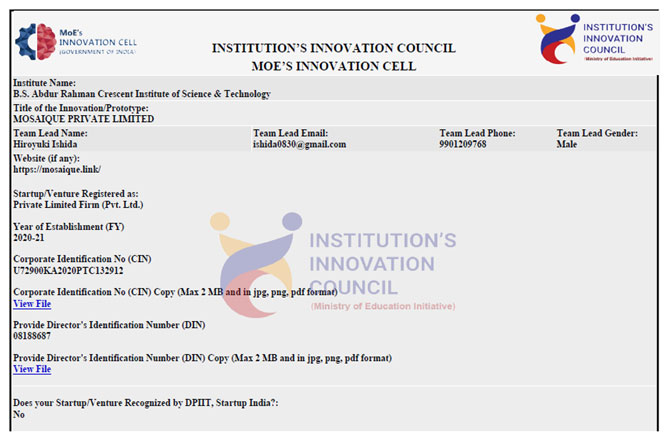
1. Kankyo Group of Companies
Kankyo Group has broad experience in Design, Engineering, Procurement and Construction of waste to-energy plants, solid waste treatment, bioremediation, wastewater and water treatment facilities. We provide all technical and management skills required to complete a project successfully. We operate as a full turnkey EPC contractor according to Global Standards. We offer far reaching solutions that extend possibilities beyond industry -norms in providing material value in terms of both financial and technological long term sustainable benefits.
KANKYO’s lake/river restoration treatment using Mira Carbon- A novel Japanese Technology. Mira Carbon’s Carbon Fiber is a fibrous carbon substance having a fine graphite crystal structure which is manufactured by carbonizing acryl fibers by a special heat treatment process. Carbon Fiber is generally said to be a light, strong, corrosion resistant advanced functional material. It is used as a water purification material, when it comes in contact with surface of water the fibers expand. Active biofilm is formed by high bioaffinity of carbon Fiber and its microorganisms decompose the contaminants.

2. Aatrel Pvt Ltd.
The vision of ATRAL is to create a green renewable energy society and also to create an ecological systematical world.
Our mission is to create a pollution-free universe healthy livable community and an essential ecosystem to preserve life on the planet and regulate climate.
During Global warming, AATREL is now working to reduce carbon dioxide (CO2) Emission to create a Renewable energies. Working Currently on Technology in Biogas & Algae
Even though, Biogas and Algae technologies are not efficient in the green energy Industry. But, in our AATREL’S MISSION A1. We are connecting both the technologies in a unique way to get efficient renewable energy. Simultaneously we can do Carbon Trading Revenue through this process. The Technology is called Algae Scrubber.
External Startups







Alumni Startups



Student Startups


![]()
https://www.ciic.ventures/our-startups/#page-1
Smart Energy Monitoring System
Smart Metering is the energy monitoring system using smart meters that track how much energy consumer are using so that they can adjust the usage when required. Installing a smart meter helps us get rid of estimated bills by allowing us to control and reduce energy consumption. Smart meters provide the real-time information about the consumption and the cost of the energy used. Based on that, the consumer can improve their energy consumption, which is important for meeting the CO2 reduction targets. In this regard, institution supports Rekindle Automations Pvt. Ltd to implement Smart Energy Monitoring System in our campus.
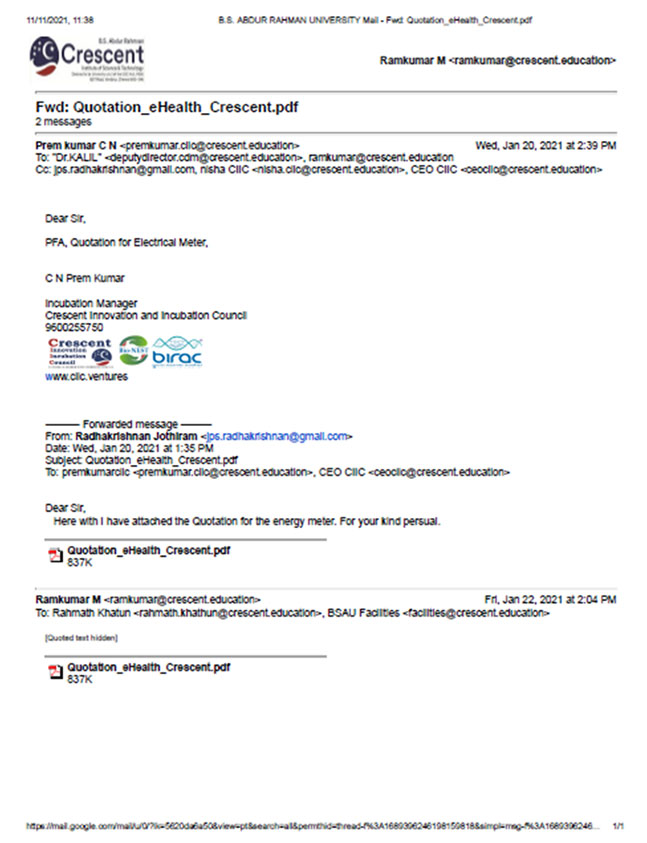
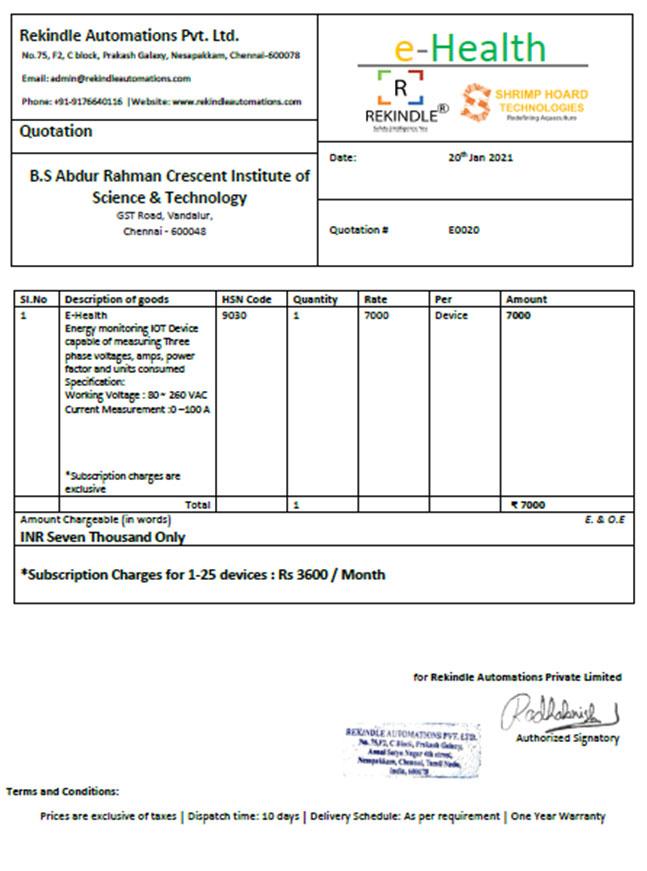
SDG 7
- Policy & Standards – Energy efficient – New Building
- Upgrade buildings to higher energy efficiency
- Carbon reduction and emission reduction process
- Plan to reduce energy consumption
- Energy waste identification
- Divestment policy
- Energy Usage per Sqm
- Local community outreach
- Renewable energy pledge
- Energy efficiency services for industry
- Policy – clean energy technology
- Low – carbon innovation
- Policy & Standards – Energy efficient – New Building
- Upgrade buildings to higher energy efficiency
- Carbon reduction and emission reduction process
- Plan to reduce energy consumption
- Energy waste identification
- Divestment policy
- Energy Usage per Sqm
- Local community outreach
- Renewable energy pledge
- Energy efficiency services for industry
- Policy – clean energy technology
- Low – carbon innovation



